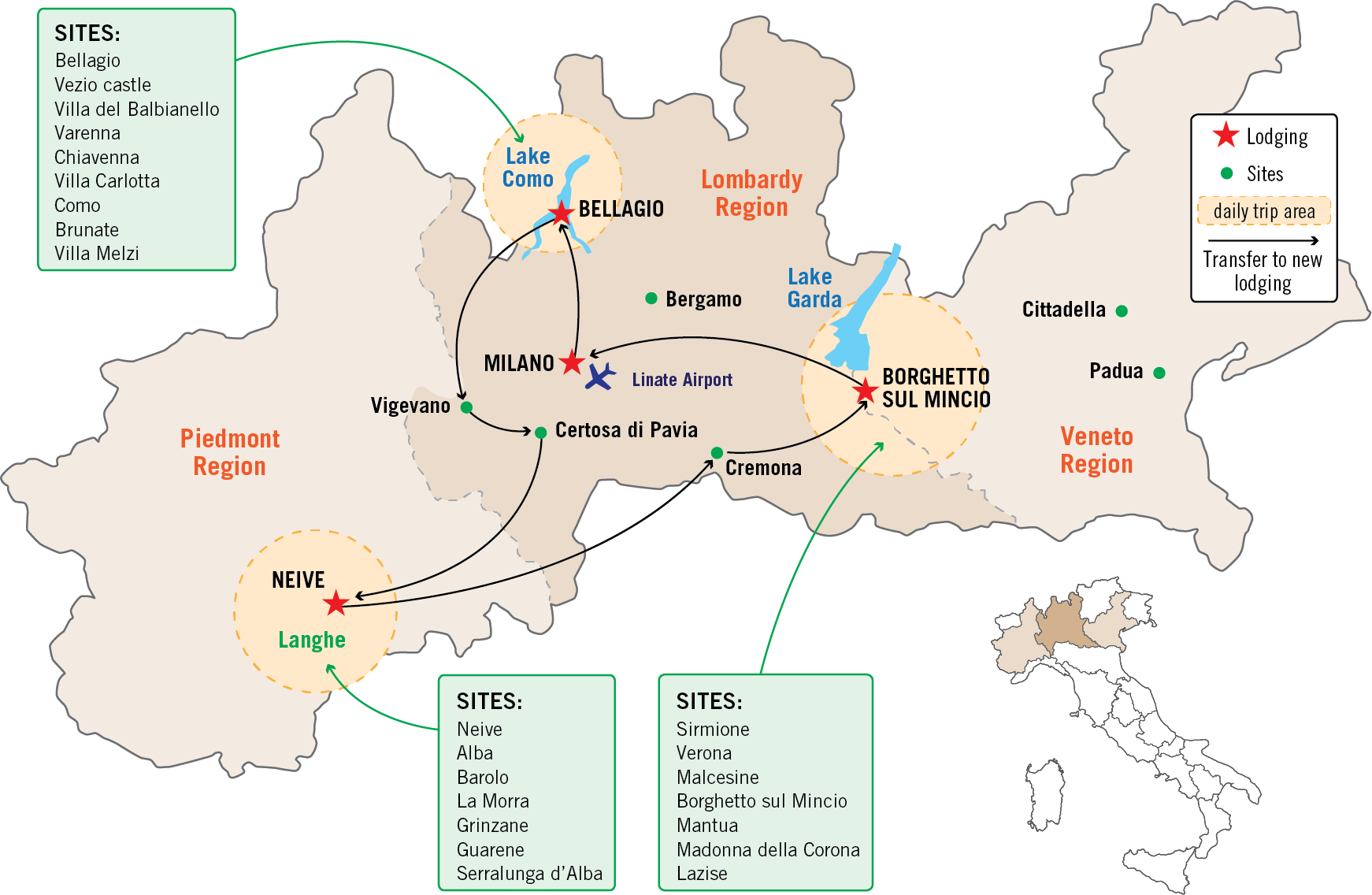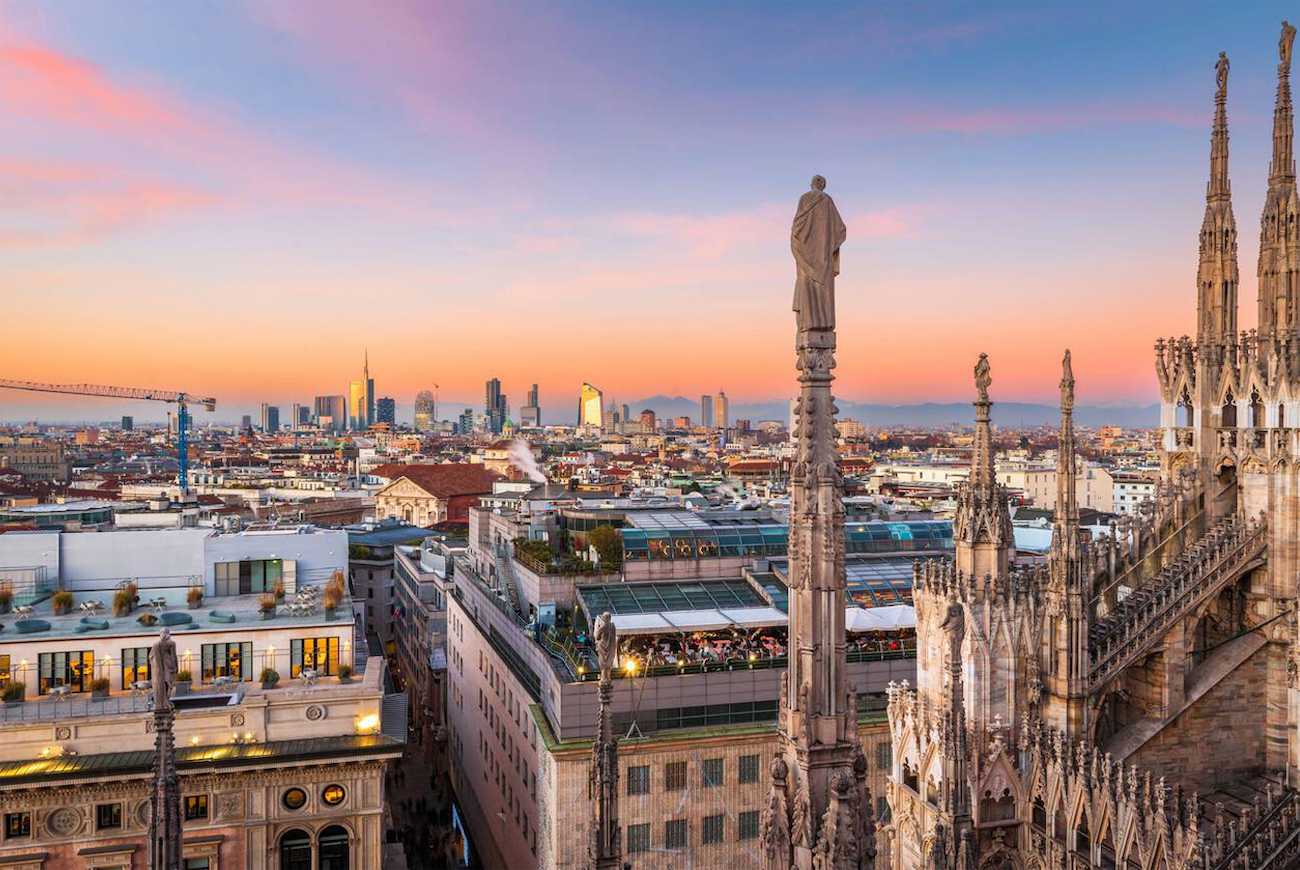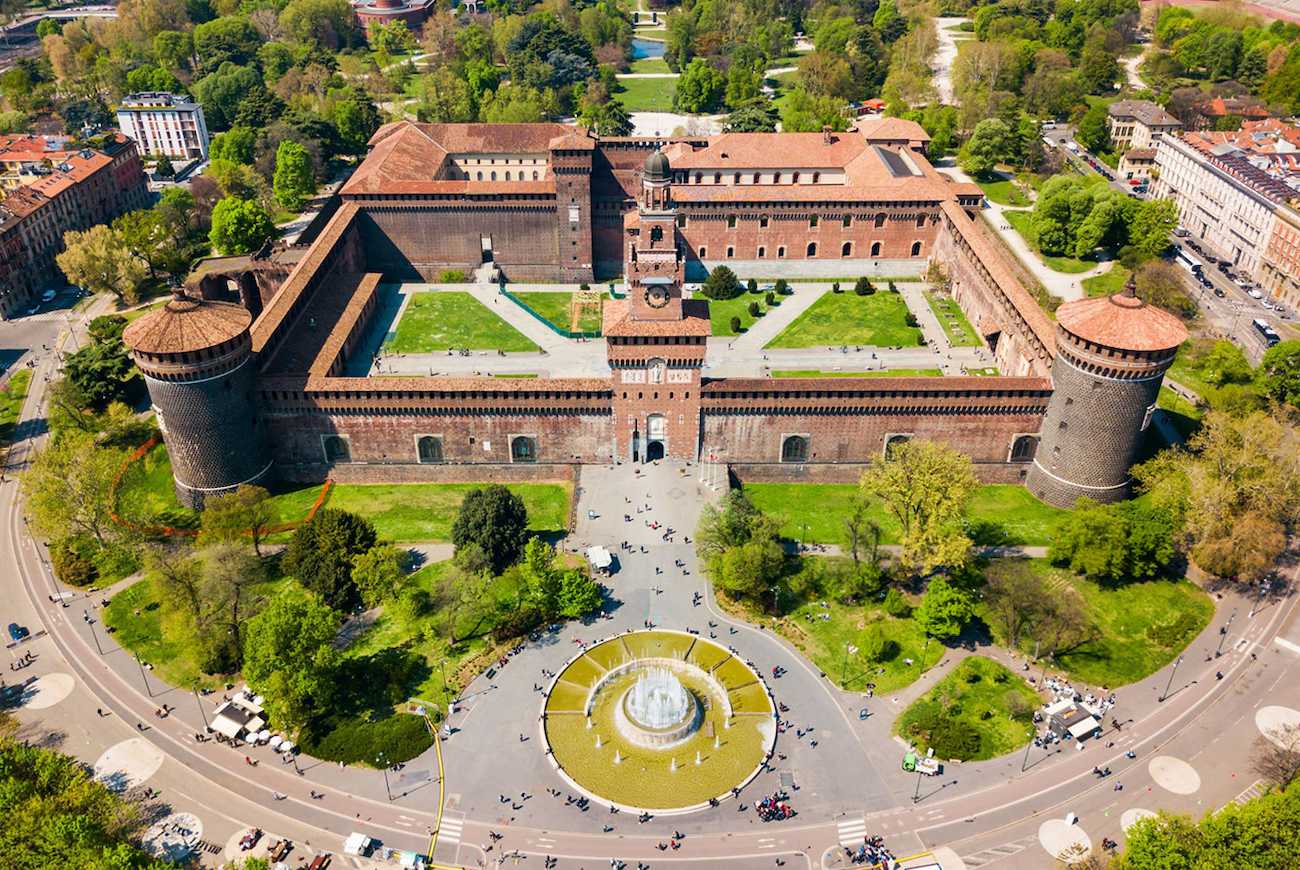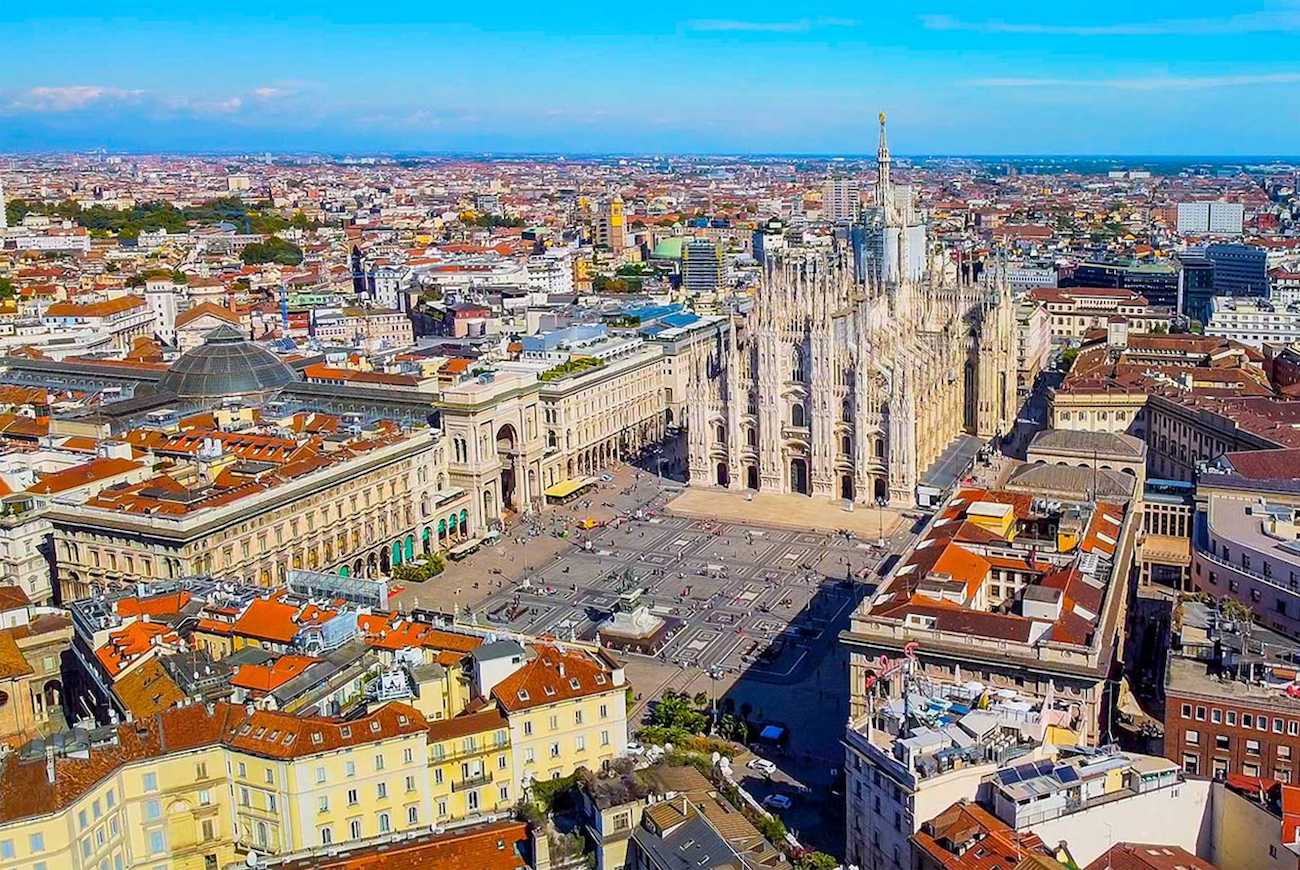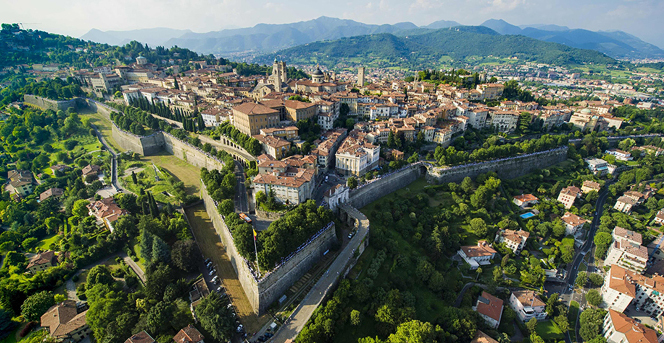~ NORTHERN ITALY ~
Ben Arrivati! Welcome to Italy, Welcome to Milan!
Airport pick up.
Hotel check-in (3 night stay).
Optional activities available according to arrival time.
Welcome Aperitif.
Dinner at a restaurant pizzeria.
Milano
Milan, the capital of the Lombardy region, thrums with an energy unlike any other. It is the second most populous city in Italy and the main industrial and financial center, home to the national stock exchange. History echoes from ancient cobblestones, while fashion struts along modern avenues such as the Galleria Vittorio Emanuele II. This picturesque meeting point, a covered arcade with an iron and glass framework and the oldest shopping center in the world, acts as a central hub leading to both Piazza della Scala, where the famous opera house and concert hall is located, and Piazza Duomo, dominated by the magnificent Cathedral with its intricate Gothic spires. By stepping inside the Duomo, you’re dwarfed by the high standing columns and the stained glass windows that shimmer with a thousand colors. The visionary Leonardo da Vinci once lent his engineering expertise to the now-trendy Navigli canals. Today, these canals boast cozy bars that transform into vibrant nightlife destinations. A different side of da Vinci’s genius can be seen in the famed fresco, L’Ultima Cena (The Last Supper), housed at Santa Maria delle Grazie church. Other city landmarks include the brick-built Sforza Castle, once a powerful fortress and now boasting extensive art museums, and the historic opera house La Scala, one of the world's leading theaters for opera and ballet, renowned for its grand architecture and prestigious performances. There is also a Modern Milan, the sleek skyscrapers of the Porta Nuova district piercing the skyline, a testament to the city's constant evolution. Whether you're a history buff, a fashion aficionado, a foodie, or simply a seeker of vibrant experiences, Milan has something waiting to surprise and delight you.
Inside the famous Galleria Vittorio Emanuele II, there's a mosaic depicting a bull. Legend has it that if you spin three times with your heel on its private parts, it will bring you good luck!
The Glorious Artists
Morning
- Subway ride to downtown Milan.
- Walking guided tour:
- The Last Supper of Leonardo da Vinci in Santa Maria delle Grazie church.
- San Maurizio al Monastero Maggiore church, an impressive piece of art and considered the Milano ‘Sistine Chapel’ with striking fresco decorations.
- Pinacoteca Ambrosiana which houses masterpieces from artists such as Caravaggio, Bernardino Luini, and Raffaello.
Afternoon
- Walking guided tour:
- Sforza’s Castle, one of the most well known landmarks in Milan and home of several museums.
- Free time or optional activities:
- La Scala, one of the world’s oldest and most famous theaters founded in 1778 that soon became the home of great Italian composers such as Rossini, Bellini, Donizetti, Verdi and Puccini.
- Continue exploring the historic center.
The Last Supper
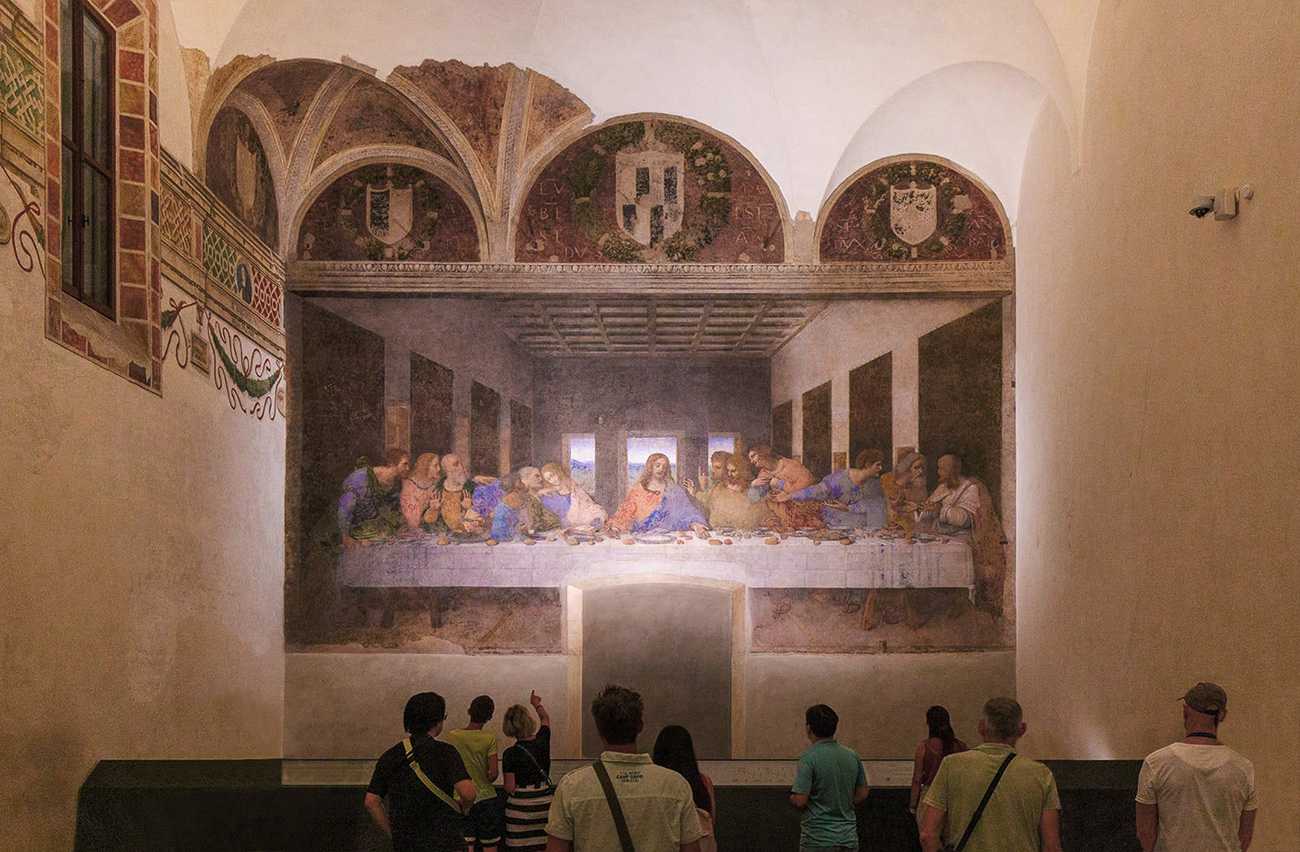
Is one of the most admired, most studied, and most reproduced mural paintings the world has ever known. A celebrated work of art that displays complex human emotions and their expression and masters perspective, light, space, motion and other artistic elements of the High Renaissance. It measures 15 feet by 29 feet. Leonardo did not use the traditional fresco technique but chose a method that would enable him to paint on dry plaster and work slowly, so as to be able to make changes.
San Maurizio
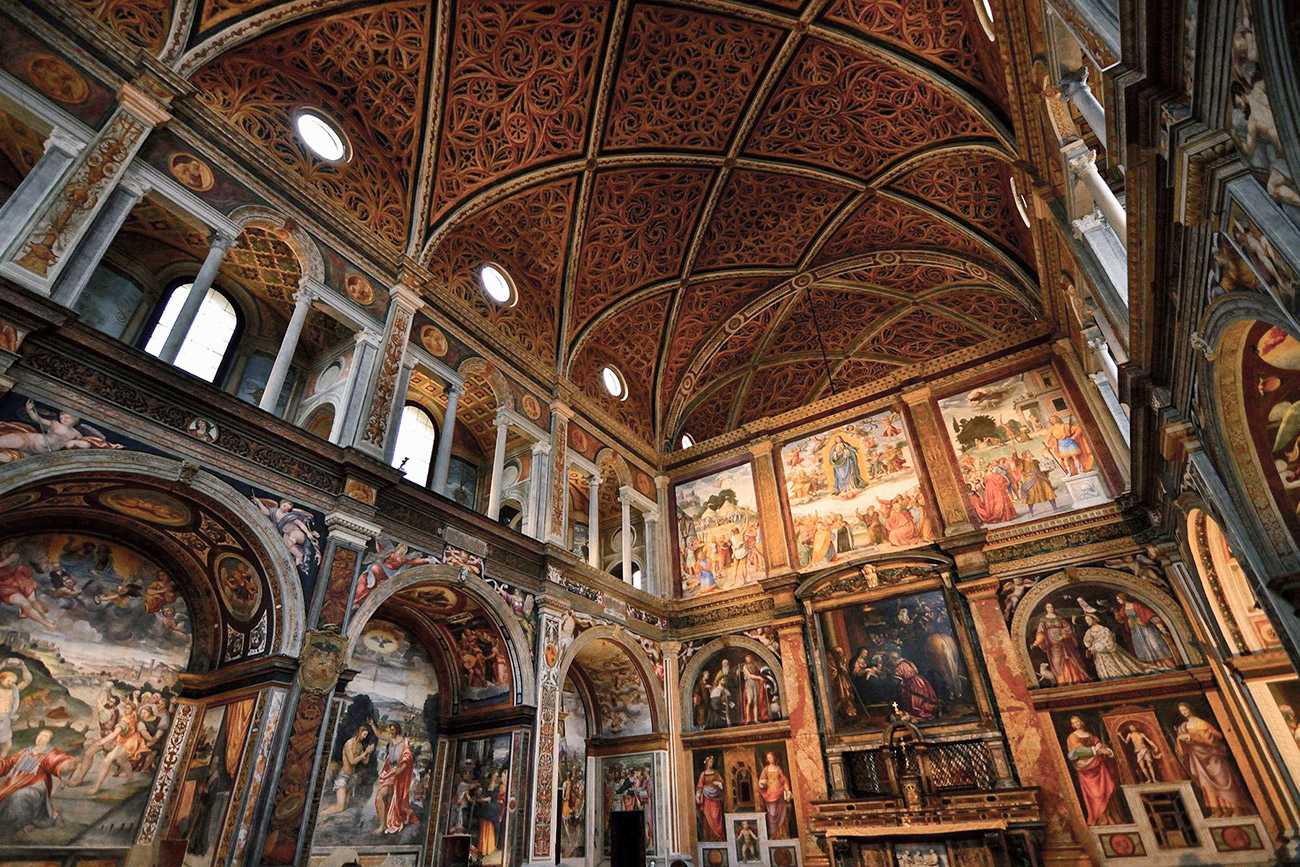
The sober exterior of San Maurizio al Monastero Maggiore church is a very simple structure that hides a magnificent interior, with splendid decorations that resembles in richness the ‘Sistine Chapel’ in Rome. The church was originally connected to a Benedictine convent which explains its name ‘Monastero Maggiore.’ Thanks to the generous donations from the nuns noble families and other important benefactors, various artists were commissioned to embellish the interior, among them Bernardino Luini, an important artist of the time and friend of Leonardo da Vinci, whose contributions can be admired around the altar.
Castello Sforzesco
The Sforza Castle was built during the 14th century and today is one of the most astounding fortified structures in Italy and one of the largest in Europe. It has transformed over the course of several centuries by the will of the various noble families who have governed it or during its foreign dominations. After post World War II restoration, the castle was reborn as a cultural center and home of several museums and exhibitions such as the Egyptian museum, the Musical Instruments Museum and the Antique Furniture and Wooden Sculpture Museum. Its highlights are the Rondanini Pietà, the last and unfinished work by Michelangelo, and the ‘Sala delle Asse’ by Leonardo da Vinci, becoming dear to the hearts of the Milanese and as such, a symbol of the city.
Teatro alla Scala
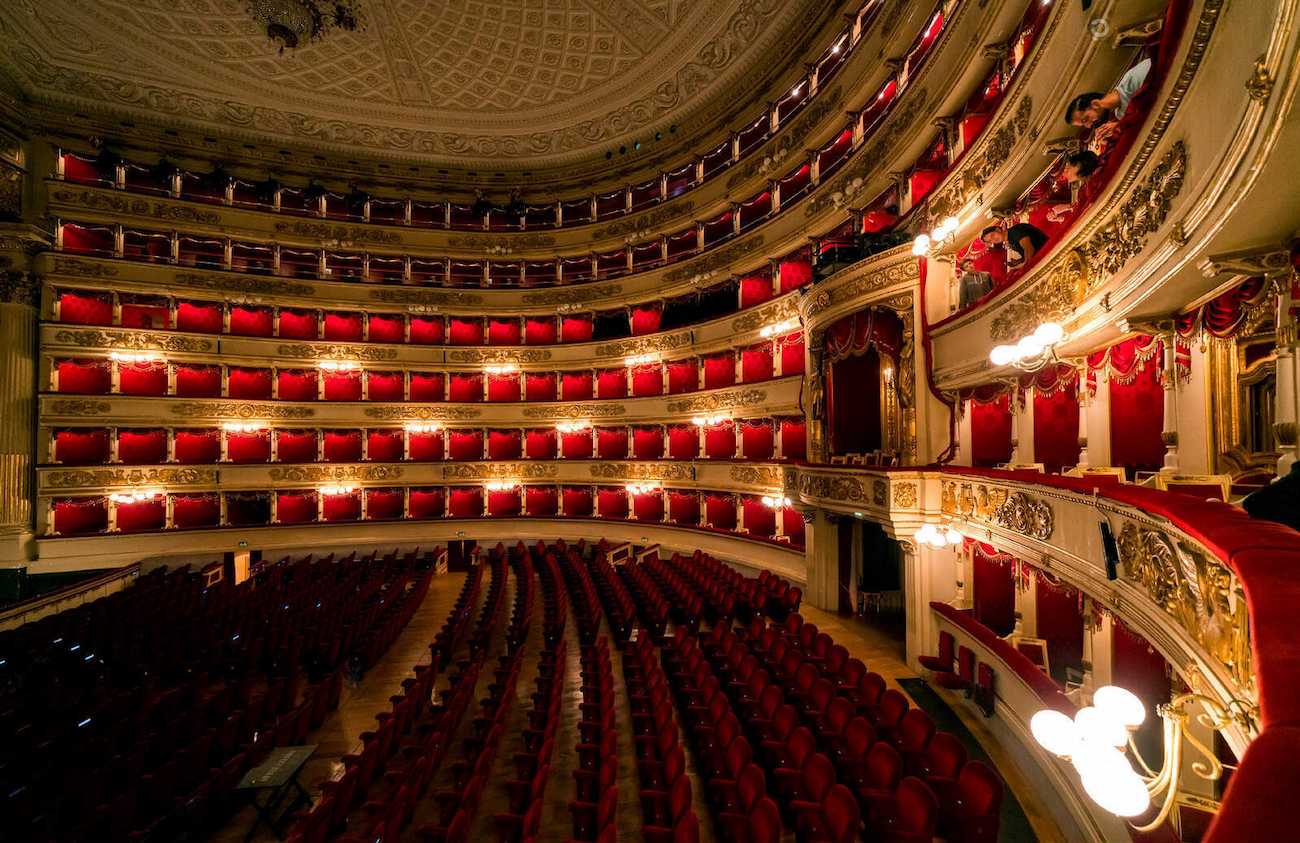
La Scala is one of the principal opera houses of the world and the leading Italian house. Built in 1776–78 under the auspices of Empress Maria Theresa of Austria to replace the Royal Ducal Theatre, destroyed by fire. The cost was borne by the owners of the boxes at the Ducal, in exchange for possession of the land on which stood the church of Santa Maria alla Scala (hence the name). Designed by Giuseppe Piermarini, La Scala opened on August 3rd, 1778 with Antonio Salieri’s opera l’Europa Riconosciuta.
Milan and its Masterpiece
Morning
- Subway ride to downtown Milan.
- Guided tour inside and on the roof-top of the Duomo, a masterpiece of Gothic architecture.
Afternoon
- Subway ride back to the hotel.
- Drive to Bergamo ‘Cittá Alta’, the historic upper part of the city.
Walking guided tour:
- Basilica di Santa Maria Maggiore, a unique combination of different style elements.
- Cappella Colleoni, a chapel from the Renaissance period.
- Torre Civica, also called the ‘Campanone’ (Big Bell).
- Aperitif in Piazza Vecchia, the main square in ‘Città Alta’.
- Funicular ride to San Vigilio, a small town above Bergamo overlooking the Padana Valley (Po Valley).
The Duomo
The most impressive building in Milan and one of the largest churches in the world. Nowhere else will you find a structure with 3,400 statues, weighing 325,000 tons! The Duomo’s 55 stained glass windows include over 3,600 characters; it also has 200 bas-reliefs, 96 gargoyles and 700 figures. The Duomo’s 135 marble slender spires give this monument its unique outline. On the rooftop you can fully appreciate the architecture and the breathtaking views over the city. The construction of the Duomo officially began in 1386 founded by Milan’s ruler Gian Galeazzo Visconti, founder of the Veneranda Fabbrica del Duomo di Milano, a 600-year-old organization that was established to supervise the construction of the Milan Cathedral. Today, it is still actively involved in the preservation of the building with a project that began in 2002. Routine restorations and cleaning are continually taking place to maintain its gleaming stone, making the Duomo the longest-worked cathedral in the world.
Bergamo
is located 25 miles from Milan and is the second most visited city in Lombardy. It is divided into Città Alta, the upper town and historic center, and Città Bassa, the lower modern expansion of the city. In the 16th century, when the town was ruled by Venice, a massive defensive wall with towers, bastions and 4 gates was built all around Città Alta which in 2017 became a UNESCO World Heritage Site. The area where Bergamo stands now was initially an Orobi settlement during the Iron Age. Named Bergomum during Roman times, it was destroyed in the 5th century by Attila the Hun. After being rebuilt it was ruled by the Milanese Visconti family during the 12th century, then by Venice until 1797 when the town was controlled by the French. For 44 years it lived under Austrian rule until it became part of the Italian kingdom in 1859. Upper Bergamo, accessible also by funicular is a town of rare beauty. Once exited the funicular station, you are catapulted into an enchanting medieval atmosphere that can be felt walking through the narrow cobblestone streets and while visiting the historic buildings.
Cappella Colleoni
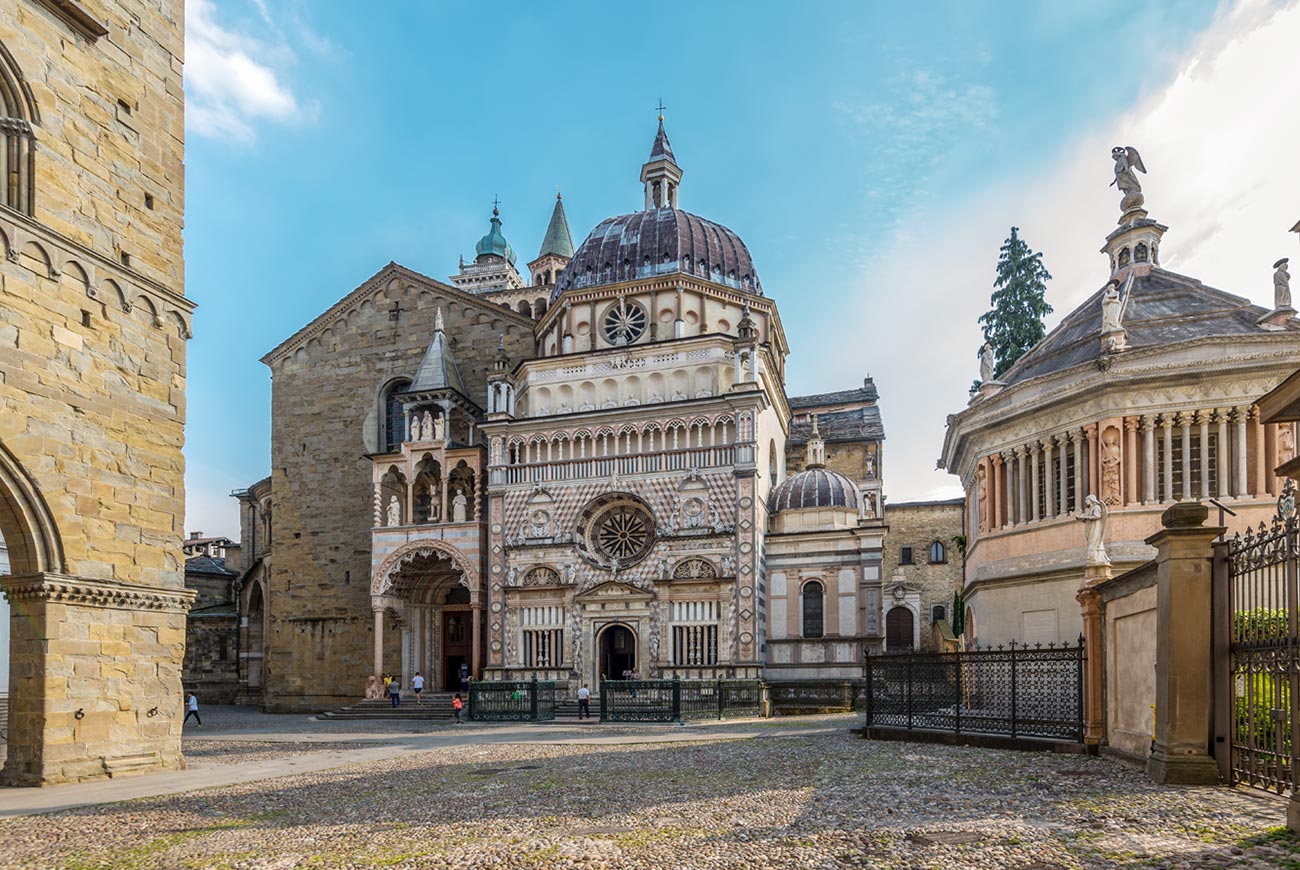
The Colleoni Chapel is surely the most beautiful building in Bergamo with ceiling frescoes by the Venetian painter Tiepolo in the 18th century. Its façade is decorated with red and white marble, an authentic Italian Renaissance masterpiece. It was built as the personal shrine for the condottiere Bartolomeo Colleoni, one of the most famous mercenary captains in Italy.
Basilica di Santa Maria Maggiore
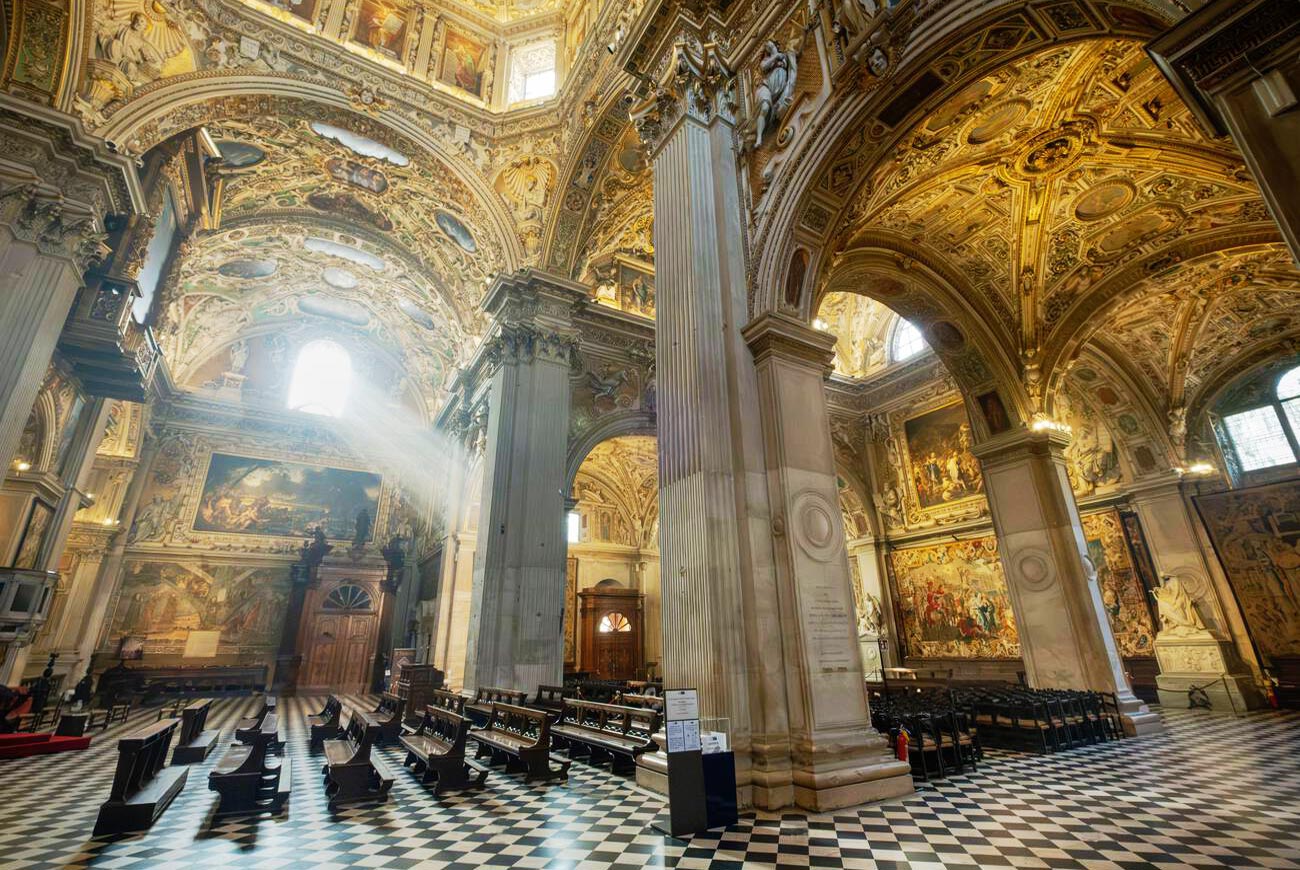
The Basilica was built in 1133 as a result of a vow made by the people of Bergamo to the Virgin Mary that if she protected the population from the plague epidemic, as a sign of gratitude, they would have dedicated a church to her. Although the Basilica lacks a central entrance and facade, its interior, partly frescoed and rich in stucco, tapestries and wooden marquetry, makes it very beautiful and fascinating. Between the two portals on the north side, the ancient commercial measures in use in Bergamo in the Middle Ages are fixed on the wall: the Capitium Comunis Pergami (rod) and the Brachium (arm’s length), used as a reference point by weavers and merchants.
Piazza Vecchia
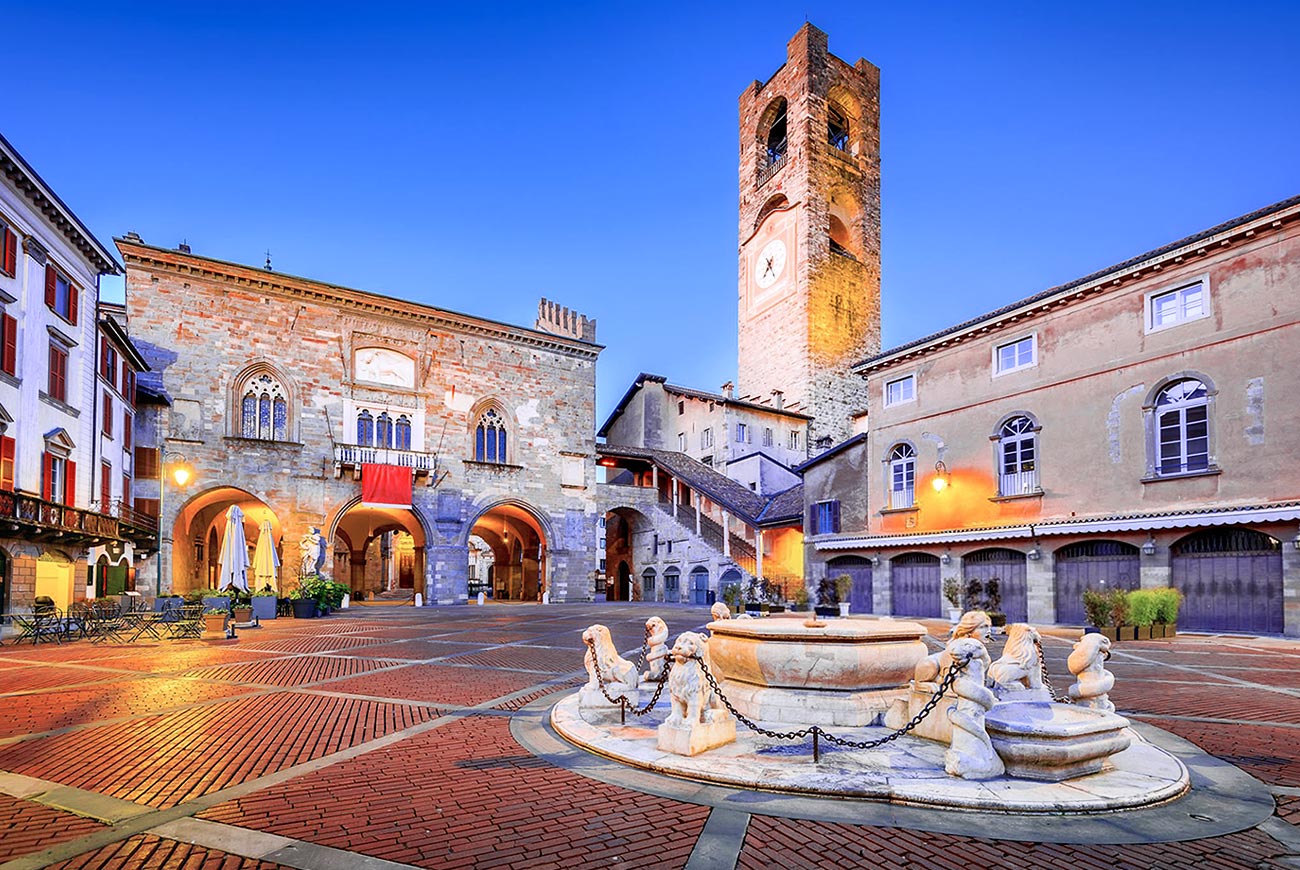
Built where once was the ancient Roman forum, Piazza Vecchia has been the heart of political power for centuries and is today considered the center of Città Alta (Upper Town), a place for meetings and social life. On one side of the square stands the Palazzo della Ragione, center of the medieval town, where public edicts were issued and business were carried out. Nearby stands the City Tower, which the Bergamask people prefer to call the ‘Campanone’ (Big Bell) with the oldest bell in Lombardy. From the top reached by foot (230 steps) or by lift, you can enjoy a breathtaking panoramic view.
Bellagio, the Beautiful, Pearl of the Lake
Morning
- Drive to Como, also known as the ‘Silk City’, for its long tradition of silk manufacturing.
Optional activities:- Gothic Cathedral.
- Silk Museum.
- Walk along the lakeside.
- Funicular ride to Brunate, the town that overlooks Como city and the lake.
Afternoon
- Walk to the Faro Voltiano, the lighthouse & memorial to electrical pioneer Alessandro Volta, with lake and Alps views.
- Drive or take a boat ride to Bellagio, the ‘Pearl of the Lake’ located at the apex of the peninsula where Lake Como joins Lake Lecco.
Welcome Aperitif.
Dinner at the hotel with a view of the lake.
Como
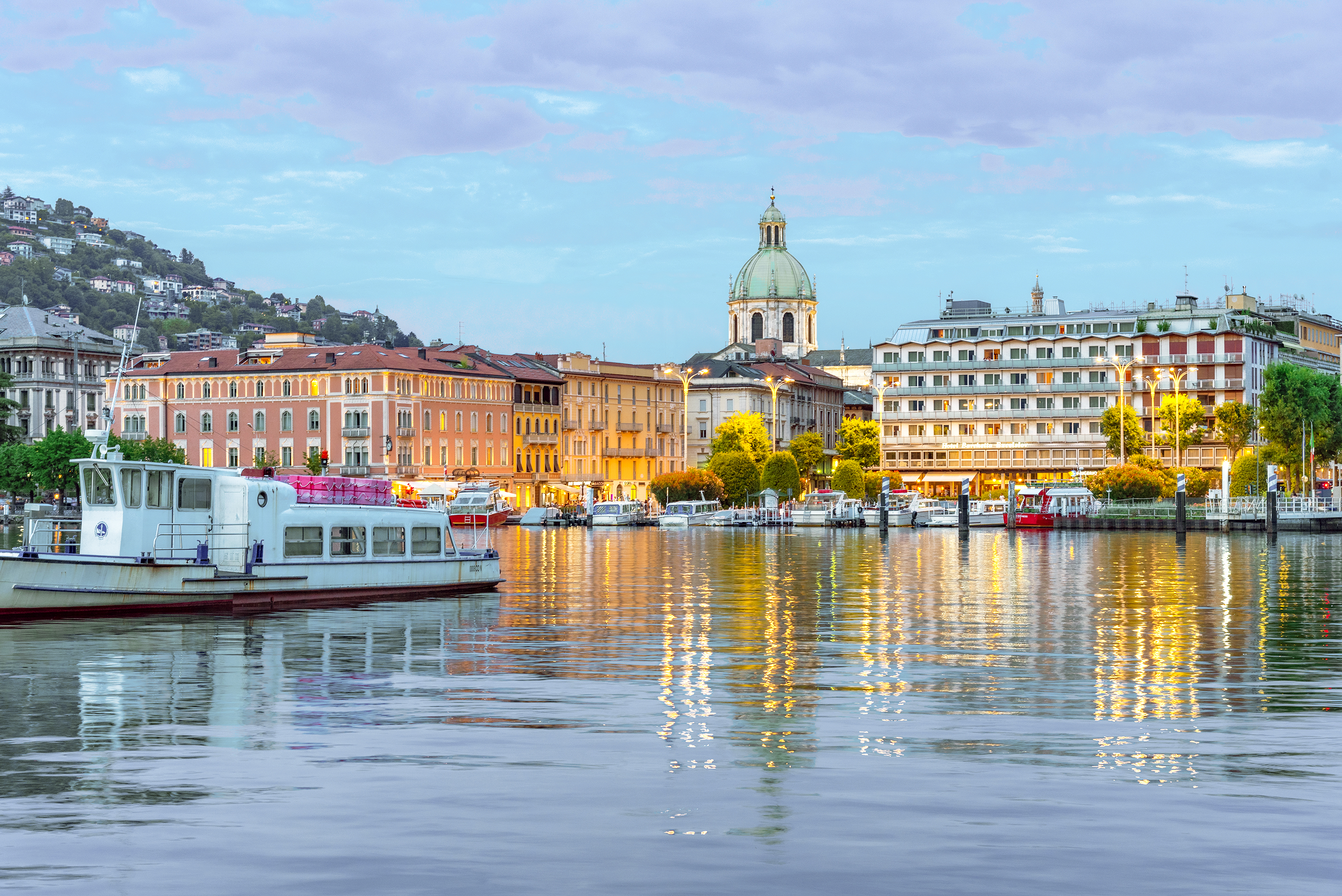
Como, a prosperous city, is located on the southern tip of the lake. During the Roman era it was the most important northern city, the extreme outpost on the threshold of the Alps. After a series of foreign dominations, Spanish, French and Austrian, in 1859 with the arrival of Giuseppe Garibaldi, the city became part of the Kingdom of Italy. During the Roman era, Pliny, the Elder and the Younger were citizens of Como, members of one of the most illustrious family dynasties of science lovers of all antiquity. Como was also the birthplace of Alessandro Volta, the Italian physicist and chemist, pioneer of electricity who is credited with the invention of the electric battery. Until the 1980s, the city’s economy was mostly based on silk manufacturing which began as early as the 14th century making Como famous all over the world until the competition with China forced it to look for new sources of income, finding it mainly in tourism. Visited on foot, Como reveals its fascinating architectural with striking buildings and ancient palaces.
Brunate
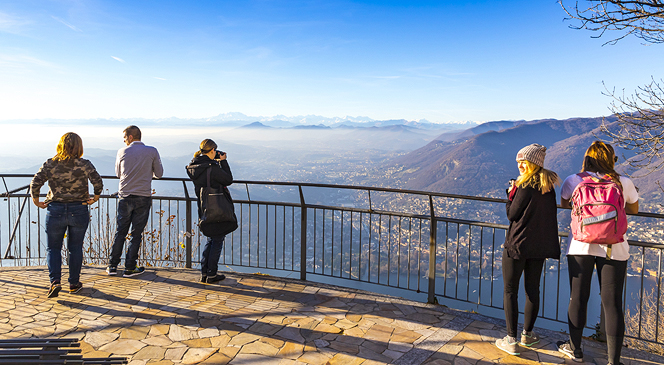
Known as ‘the balcony of the Alps’ on account of its strategic location and breathtaking views, it overlooks Como about 485 meters (1,600 ft) below and are linked by a steep, narrow, winding road, and by the Como to Brunate funicular opened in 1894. The hill is the set to splendid Art Nouveau villas, with floral motifs and eclectic elements, built from the end of the 19th century into the early years of the 20th century.
Bellagio
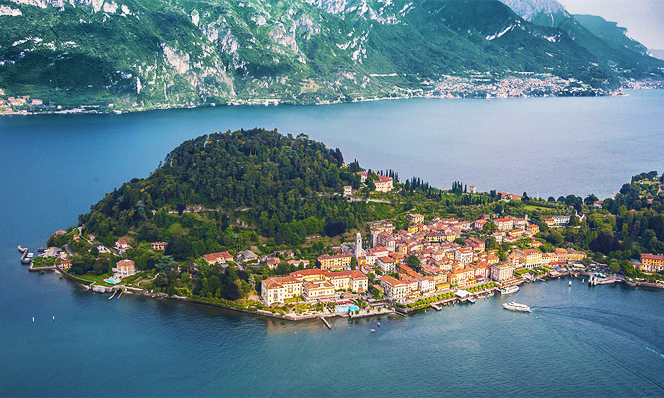
Bellagio is a picturesque village, with an abundance of trees and flowers surrounded by green hills and mountains known for it’s superbly mild climate. In the local dialect Bellagio means beautiful and is called the Pearl of the Lake. The town gained military and strategic importance during the Napoleonic period but started its transformation as an elegant and refined destination when Count Francesco Melzi d’Eril built his summer villa here which motivated other Milanese nobility to build more villas in the area. Bellagio’s fame reached outside Italy and was visited by poets and artists like Stendhal, Byron, Franz Liszt, who wrote here many of the piano pieces which became Album d'un voyageur, and Flaubert, all which contributed to the Romantic image of Bellagio and the lake as a special place to live.
Villa del Balbianello
Morning
- Boat ride to Lenno on the west side of the lake.
- 30-minute walk along the lakeside to Villa del Balbianello, located on the tip of the small wooded peninsula.
Afternoon
- Boat ride back to Bellagio.
Free time or optional activities:- Basilica di San Giacomo, one of the most enchanting and picturesque churches in the whole lake Como area.
- Explore the narrow streets and stairways of Bellagio, full of small shops and craft workshops.
- Walk one of several trails (different levels of difficulty) on Bellagio’s promontory.
Villa del Balbianello
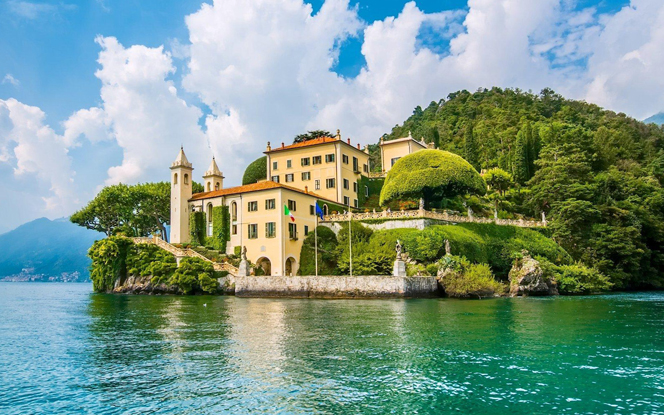
Villa del Balbianello was built in 1787 on the site of a Franciscan monastery. In 1796, Giuseppe Visconti bought the villa and made improvements to the panoramic terraced garden, which is dominated by the elegant loggia, the true gem and masterpiece of the Villa. By the first part of the 20th century, the Villa had fallen into a state of neglect. After some time, the American businessman Butler Ames bought it, bringing the gardens back to life and renovating the buildings. In 1974, it was purchased by Guido Monzino, an explorer and entrepreneur who decorated the Villa with a collection of artifacts from his expeditions.
Basilica di San Giacomo
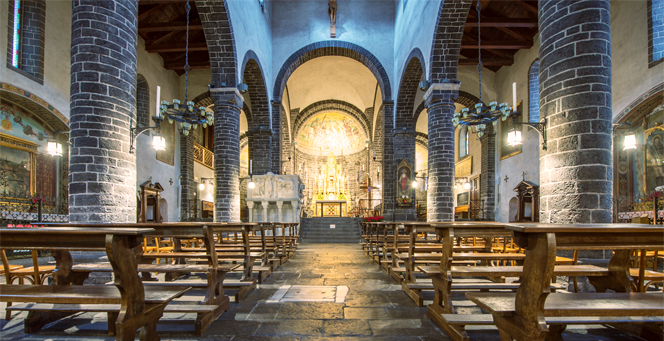
The Basilica of Saint James is a fine example of the Roman - Lombard architecture. Inside there are mosaics from the early 10th century, a ‘Deposition of Christ’ by the Perugino school, an archaic cross from the 12th century, a beautiful triptych by the 15th century Italian painter Foppa, and the ‘Buried Christ’, a polychrome wooden sculpture of the 17th century Spanish-Baroque school.
A Day of Beautiful Views
Morning
- Sail by ferry to Varenna, a small picturesque village on the east side of the lake.
- Stroll the scenic and romantic ‘Lovers' Walk’ along the edge of the lake to the historic center.
- Walk or take a ride to the remains of Vezio Castle located at the top of the hill that overlooks Varenna.
Afternoon
- Drive along the lake to Valchiavenna, a valley in the Alps, north of Lake Como.
- Walk in the city center of Chiavenna.
- Drive to Cadenabbia to take the ferry back to Bellagio.
Varenna
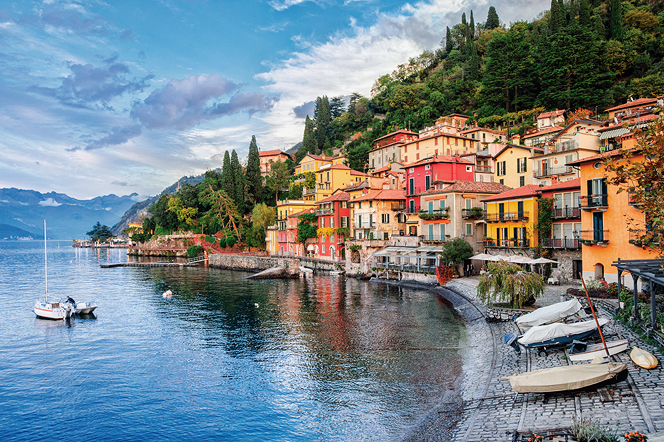
Varenna, founded in 769 by fishermen, is a picturesque village located in the center of the eastern shore of the lake, overlooking Bellagio. It is a slow-paced destination where most visitors come here to relax by the lake. The narrow alleys paved with stone and the old fishermen’s houses make Varenna another of the Lake’s gems. The nice walk along the lakeshore, called Camminata degli Innamorati (the Lovers’ Walk) brings to the beautiful picturesque Riva Grande bay with several cafes, restaurants and local artisan shops. Its most well known sites are Villa Monastero, founded as a Cistercian monastery and today a museum and botanical garden, and the Church of San Giorgio, built in the 14th century and rediscovered after some restorations in the second half of the 20th century as an example of medieval Lombard architecture.
Castello di Vezio
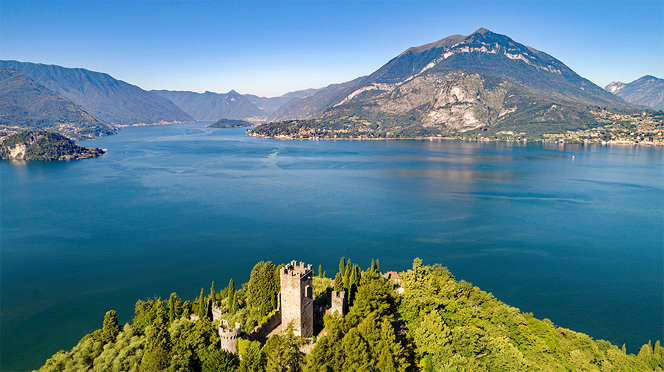
The Vezio Castle was erected by the Lombard queen Teodolinda in the late 11th century on the promontory overlooking Varenna as a military outpost to defend and control the lake and the surrounding villages. In the late 19th century, remains of tombs from the Iron Age, as well as weapons and armors, were found in the area. Partially restored in the mid-20th century, today the castle has a watchtower that can be visited right up to the top to enjoy the panoramic view of the lake. It can be reached from Varenna by foot taking a short but rather steep path. The Castle is a bird-of-prey breeding, nursing and training center.
Chiavenna
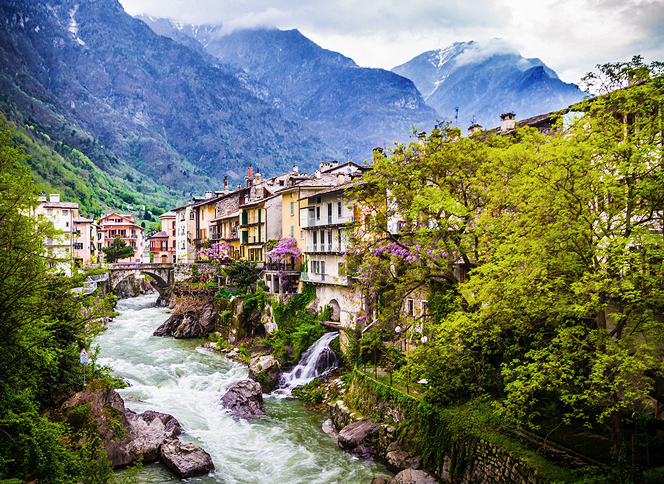
Chiavenna, the center of the Alpine Valchiavenna region, is famous for its beautiful historical center and the characteristic ‘crotti’, also called grottos, typical natural cavities of the mountainous regions of the Alps, used as natural cellars. Inside the ‘crotti’, between the cracks of the rocks, blows a cold air current, locally called Sorèl. Because of these natural features, grottos have been and are still commonly used to preserve foods, bresaola and cheese in particular, but also wines. In many cases, taverns offering local delicacies have been added to these crotti.
The Villas, Jewels of the Lake
Morning
- Boat ride to Tremezzo on the west side of the lake.
- Guided tour of Villa Carlotta. Walk in the botanical garden and visit the museum, whose collection includes works by sculptor Antonio Canova.
Afternoon
- Boat ride back to Bellagio.
Free time or optional activities:- Stroll along the lakeside up to Villa Melzi and visit its beautiful gardens.
- Drink an aperitif while admiring the view at Punta Spartivento, the extreme point of the Bellagio peninsula.
- Do your laundry at the nearby laundromat.
Villa Carlotta
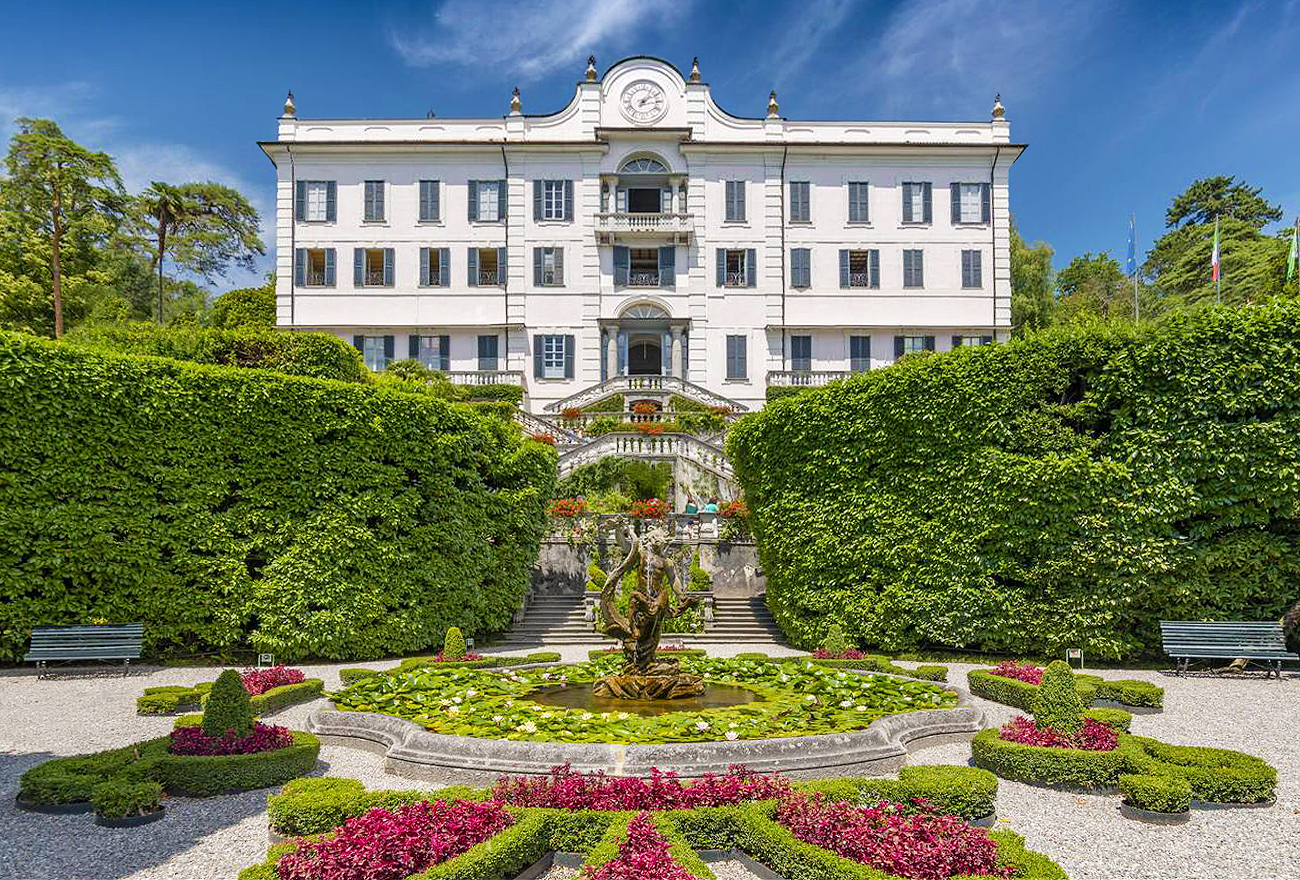
Villa Carlotta, located in Tremezzo facing the Bellagio peninsula, was built at the end of the 17th century. It is famous for its magnificent 20-acre botanical garden, sculptures and fountains. In 1801, Giovanni Battista Sommariva bought the villa and, thanks to his efforts, the villa attained its highest point of splendor, becoming a museum filled with works of art. The Last Kiss of Romeo and Juliet and Eros and Psyche are two of the many masterpieces that are part of its extraordinary collection. The villa was eventually sold to the Princess of Nassau who gave it as a wedding present to her daughter, Carlotta, after whom the villa is named.
Villa Melzi
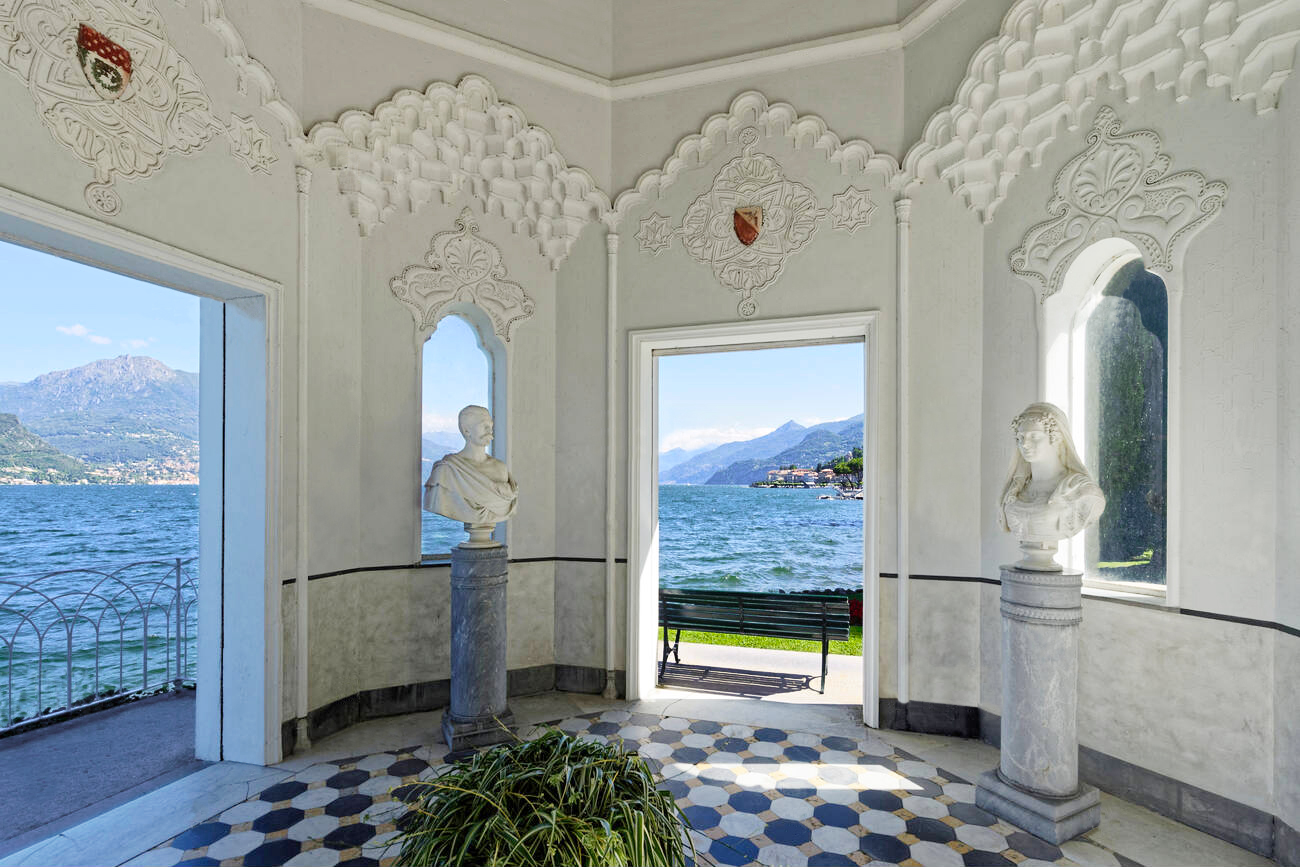
The Gardens of Villa Melzi stretch out along the lakeshore and are harmoniously inserted into the hilly scenery of the Bellagio peninsula that divides the two branches of Lario lake. The Villa, the Chapel and the orangery, today transformed into a historical museum, are splendid expressions of neo-classical style and a national monument. This architectural complex was realized between 1808 and 1810 for Count Francesco Melzi d’Eril (1753-1816), an important Italian politician.
Travel to Langhe
Morning
- Meet at 8:30 to leave for Neive in Langhe, the area recognized as a World Heritage Site by UNESCO and located in the Piedmont region.
- Stop in Vigevano, known for the portico-lined Piazza Ducale and renowned for its shoemaking history.
Optional activities:- Museum dedicated to Leonardo’s life and work during his stay in the city.
- Museo della Calzatura (Footwear Museum).
Afternoon
- Stop in Certosa di Pavia for a guided tour at the monastery.
Welcome Aperitif.
Dinner at the hotel.
Vigevano
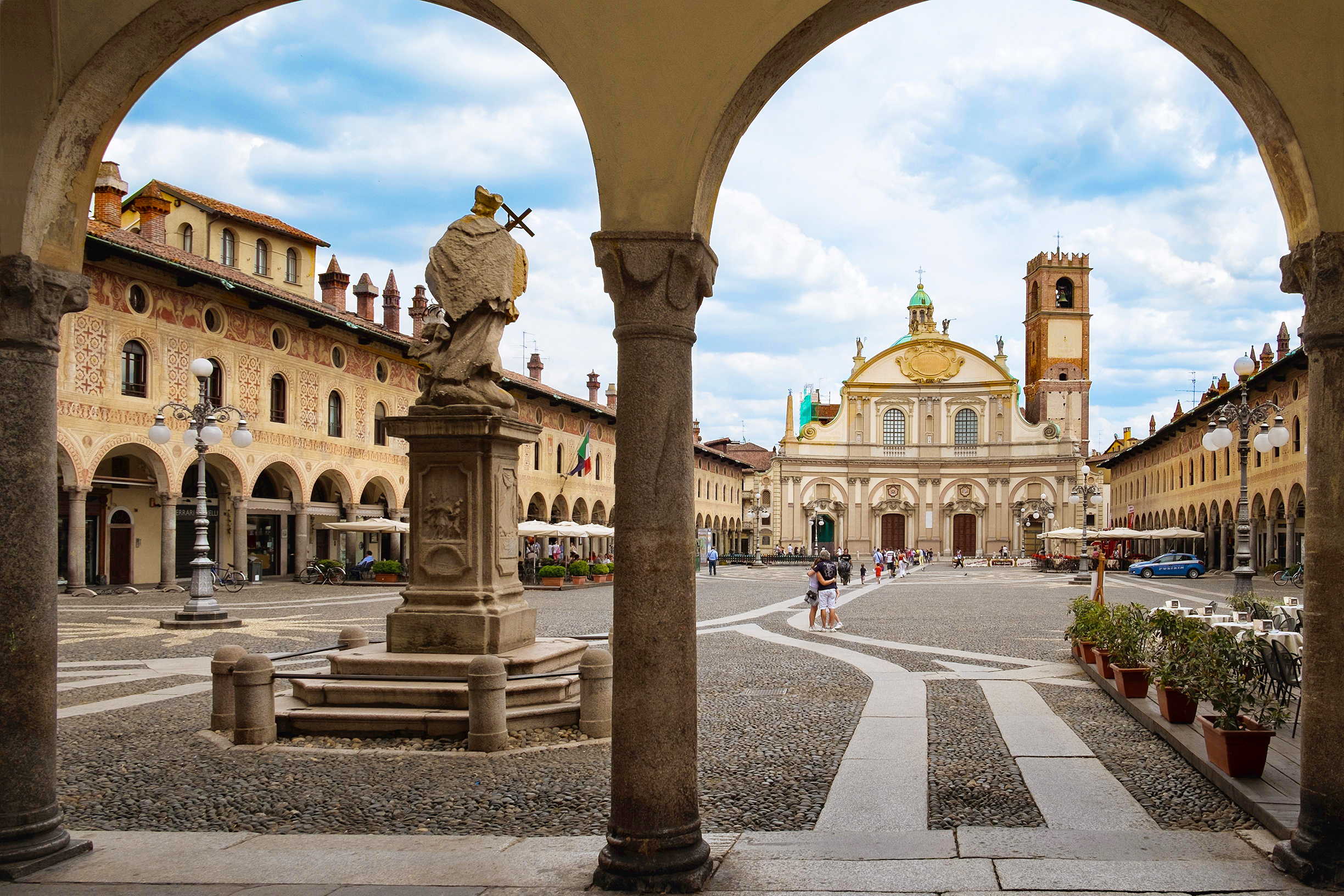
The charming little town of Vigevano is a favorite of Italians living in the surrounding area. Its Piazza Ducale is considered the model Renaissance piazza, and conductor Arturo Toscanini said that it is ‘a symphony with four walls.’ The grand piazza is surrounded by magnificent arcades with intricate frescoes on its façades, a 17th century cathedral, a famous Bramante tower, and also the Royal Palace of the Sforza. Vigevano is also renowned for shoemaking.
Certosa di Pavia
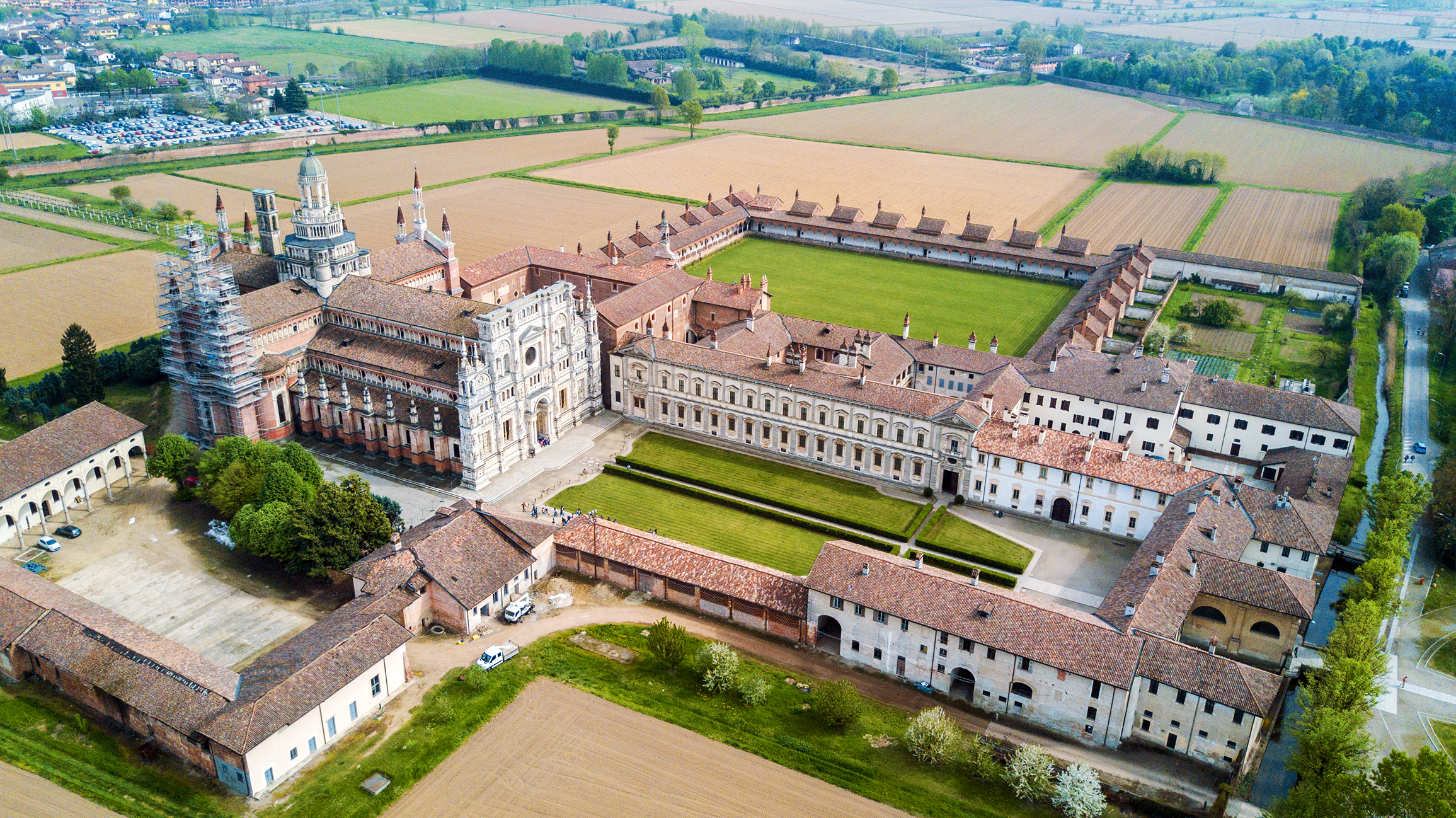
One of Italy’s largest monasteries, the Certosa di Pavia was built from 1396-1495 and is a masterpiece of the Lombard Renaissance. The best architects, sculptors and painters of the time worked on the monastery for a span of almost two centuries. A portion of the paneled painting, Madonna and Saints by Perugino, and other famous painted masterpieces by Bergognone, Guercino and Giovanni Battista Crespi can be viewed here. Equally important is its collection of stained glass windows, the marble altar frontals, the wooden choir stalls, and the notable high altar from the late 16th century.
Neive
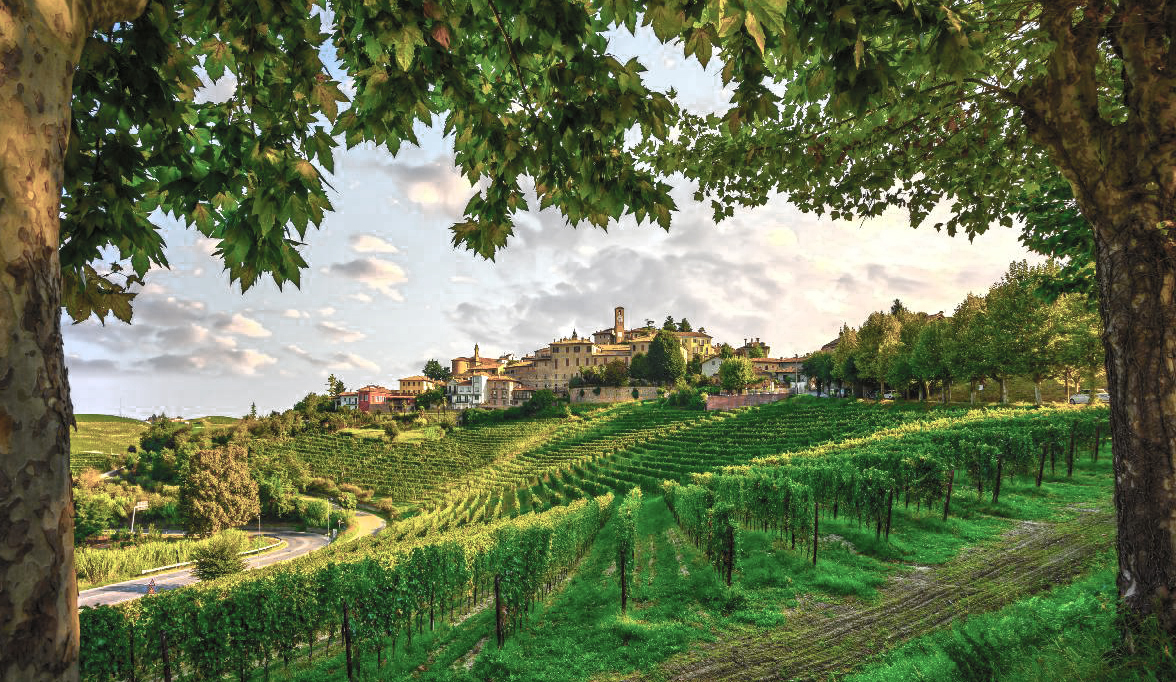
Neive is a picturesque village in the Piedmont region. The roads that lead to Neive pass through the typical landscape of rolling hills of the Langhe, a well known wine region where some of the most noblea Italian wines are produced. The historic center of Neive preserves its medieval original urban design with narrow cobbled streets that climb toward the Clock Tower.
The Family Farm Producers
Morning
- Visit Cascina Pistone, Silvio’s farm where he raises sheep that produce excellent cheeses. He will explain how cheese is made and how it is aged.
Afternoon
- Drive through the gentle hills of the Alta Langa to arrive at Cascina Barroero, the farm of Elisabetta and Stefano who will show us their hazelnut plantation and explain how their passion for the crop has translated into their wonderful confections. The visit will end with a tasting of hazelnut products.
- Grappa tasting at Distilleria Montanaro, a distillery that has produced since 1885 the most popular distilled spirit in northern Italy.
- Visit Alba, considered the capital of the Langhe.
Free time or optional activities:- San Lorenzo Cathedral.
- San Domenico deconsecrated church.
- Stroll among the beautiful buildings and enjoy the sights.
Cascina Pistone
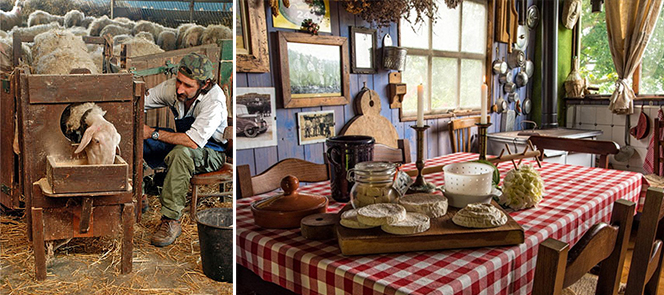
Silvio and his family live in their Cascina Pistone farm where they raise sheep to produce the typical cheese of the area, the ‘Tuma di Langa’. The processing is done with raw milk: only in this way it is possible to maintain and transfer all the organic and energetic properties of the whole milk into the cheese, as well as the aromatic richness of the high Langa pastures. This type of processing, particularly linked to tradition, determines, over the years, significant variations in taste depending on the pasture, the milk and the climate, making this cheese a live product, never standardized.
Cascina Barroero
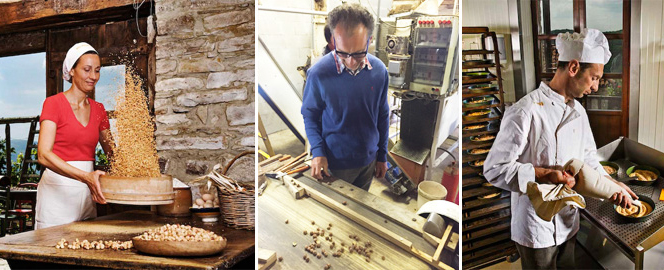
Hazelnuts in Cascina Barroero are not only grown but also transformed into confectionery products. The scrap parts, the inedible shells are used as fuel for stoves and the skins covering the fruit, as bedding for chicken coops. The Barroeros define themselves as a farming family of confectioners and they produce cakes, cookies, jams, flour and hazelnut paste for ice cream, all of superb quality.
Grappa
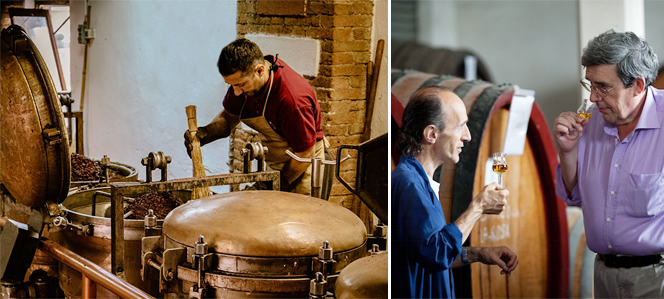
Grappa is an alcoholic beverage, a fragrant distillation of skins, pulp, seeds, and stems left over from winemaking after pressing the grapes. It was originally made to prevent waste by using these leftovers. Given the different qualities of grapes, it is possible to produce many types of grappa, which can in turn take on different qualities if it is aged in barrel.
Alba
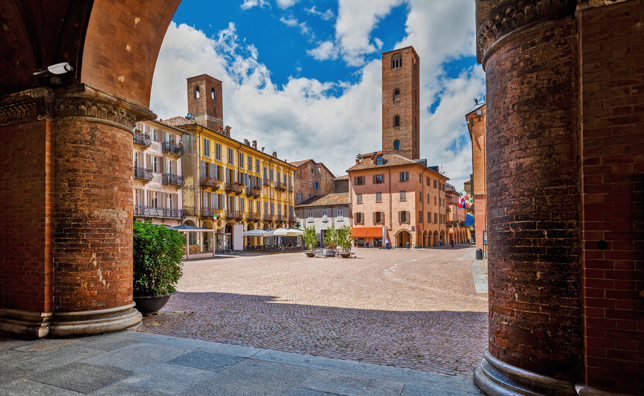
Alba is considered the capital of the UNESCO World Heritage region of Langhe. There are few destinations more enticing for gourmet travelers than Alba, a picturesque town that is renowned world-wide for its succulent white truffles, and the well-known Dolcetto d’Alba wine. The International White Truffle Fair in Alba is one of the main Langhe events held in Autumn that draws many people interested in unique culinary experiences. Worth seeing are the Alba Cathedral, which is dedicated to Saint Lawrence, and the Church of St. Dominic, one of the few examples of Primitive Gothic architecture in Piedmont and just recently restored.
Cattedrale di San Lorenzo
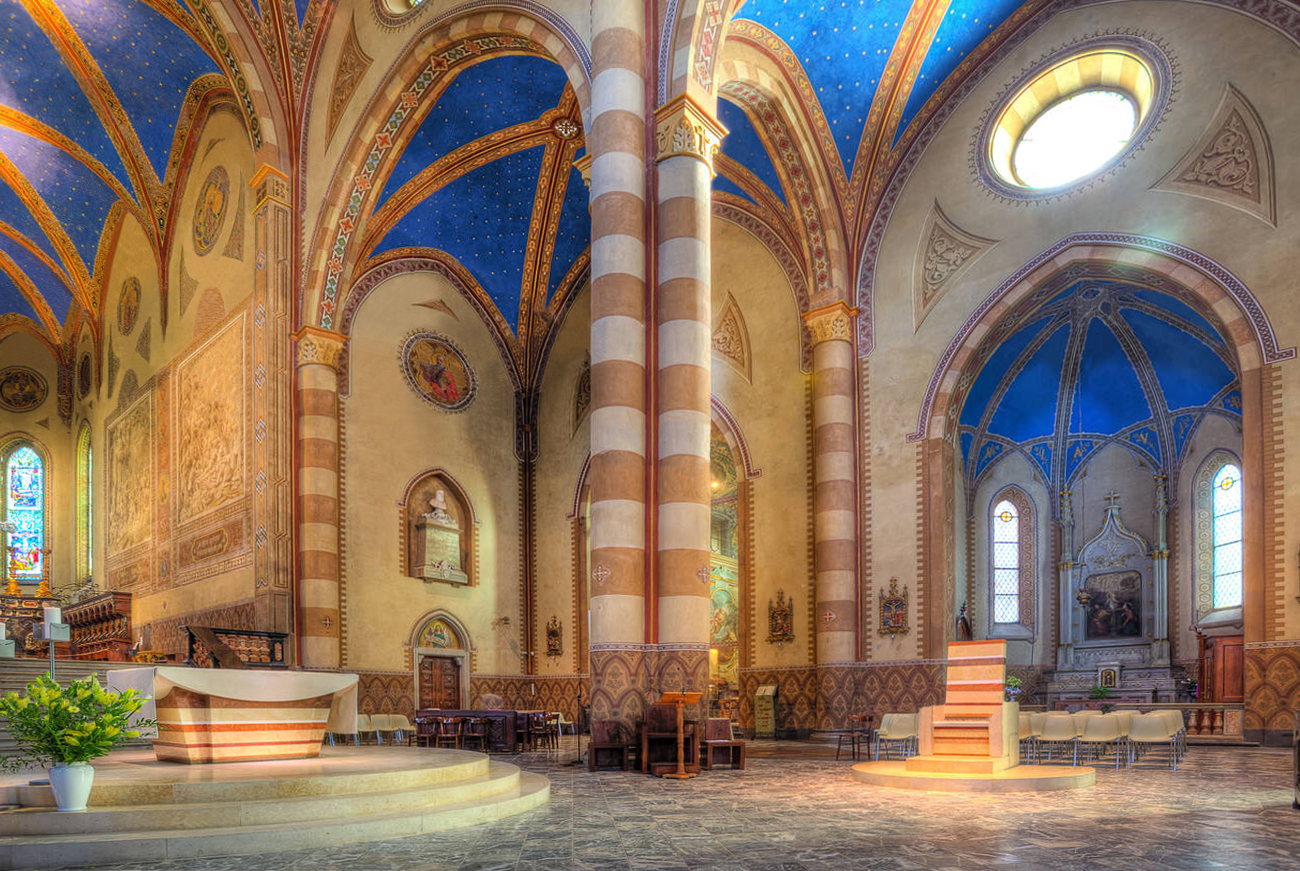
The San Lorenzo Cathedral is one of Alba’s most significant sights. The current structure dates to the 12th century. In the 15th century it was reshaped in the form of late Gothic architecture made entirely of red bricks, dominating Piazza Risorgimento (known as Piazza Duomo). There are lovely variegated columns and beautiful blue coloring on the ceiling. Some Roman remains are on display under a glass floor. It is one of the few churches where it is allowed to explore behind the altar.
The Land of the Barolo Wine
Morning
- Drive to La Morra, the town with the ‘Langhe lookout’, offers a spectacular endless view of the vineyards in the heart of the Barolo wine area.
- Drive or walk (about an hour) through the vineyards to arrive at Barolo, the city that gives its name to the homonymous wine.
Optional activities:- WiMu, wine museum at the Falletti castle.
- Corkscrew Museum.
Afternoon
- Visit the Serralunga d’Alba Castle where our guide will explain the interesting history of this manor.
La Morra
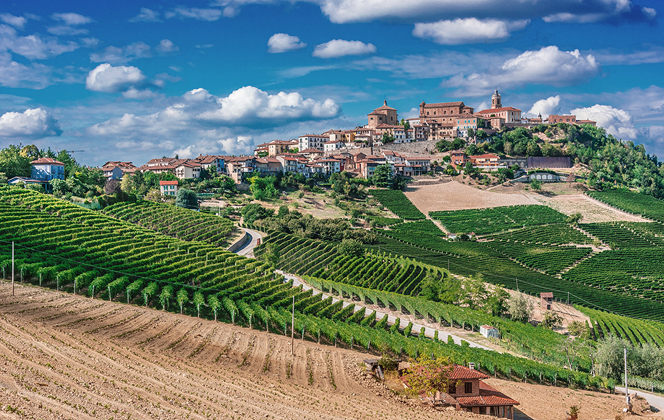
La Morra is an ancient town that enjoys a desirable location, surrounded by vineyards and hazelnut groves. The origin of its name is controversial, some say that it comes from the Latin ‘murra’, a space surrounded by stone walls where animals were gathered; others think it comes from ‘mora’, blackberry, or from ‘mola’, mill. La Morra is known for its ground characterized by the presence of clays rich in limestone that gives the soil a yellowish gray color known as Sant’Agata Fossil Marl, perfect for the production of Nebbiolo grapes from which the famous Barolo is made.
Barolo
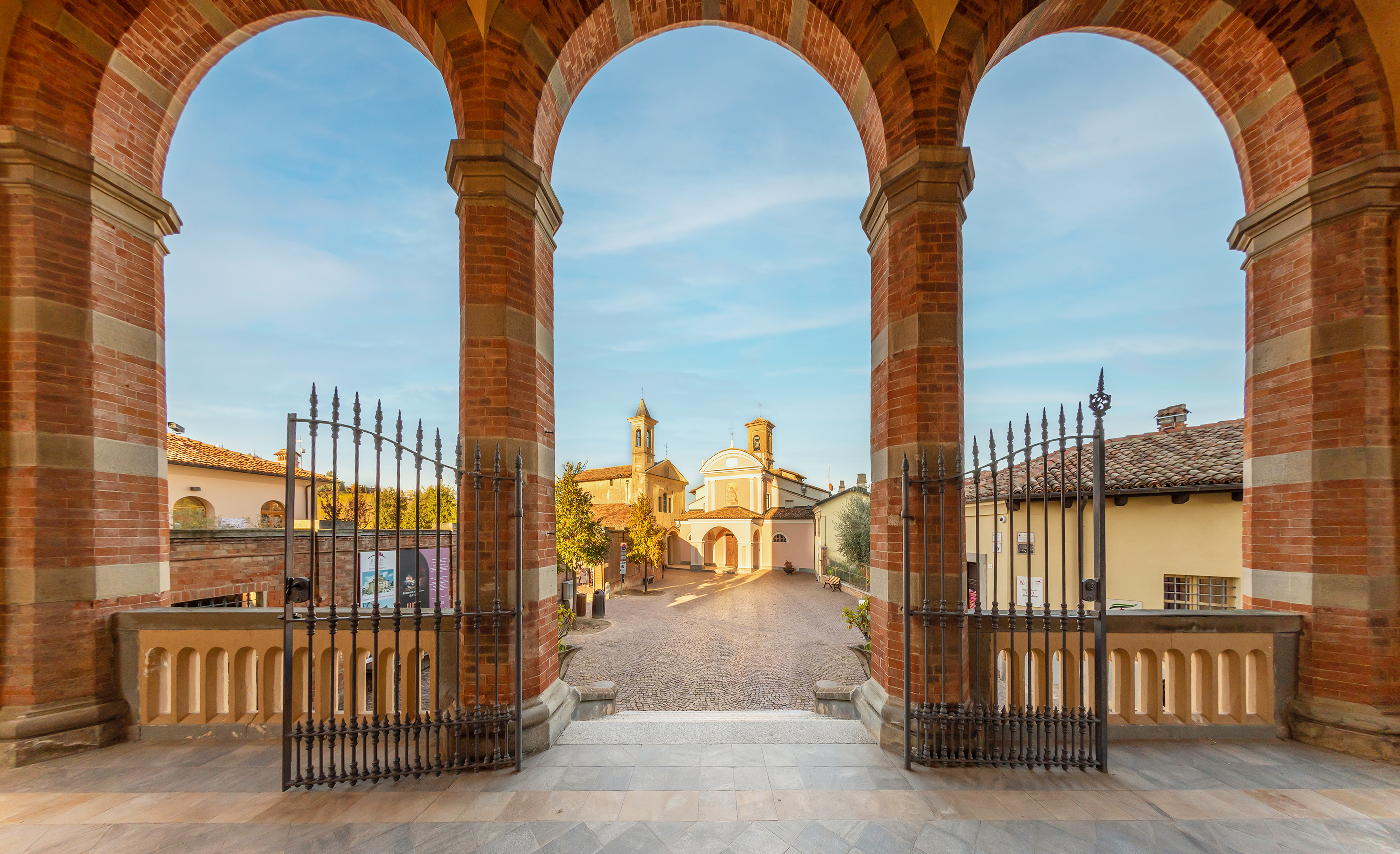
Barolo is a scenic small town surrounded by spectacular countryside, known mainly for its wine. It is possible that it was already inhabited in prehistoric times and later by Celtic-Ligurian tribes, subsequently subjugated by the Romans, then the first actual settlement, of barbarian origin dated back to the early Middle Ages. In 1250 the powerful and rich Falletti family acquired the entire possessions of Barolo from the Municipality of Alba which marked the fate of Barolo and the surrounding areas for a few centuries thanks to the Falletti’s economic power. Today Barolo is a wine country and its presence can be felt on every street corner. Barolo wine, which is unique, makes Barolo a sort of mecca to all who appreciate wine.
Castello di Serralunga d’Alba
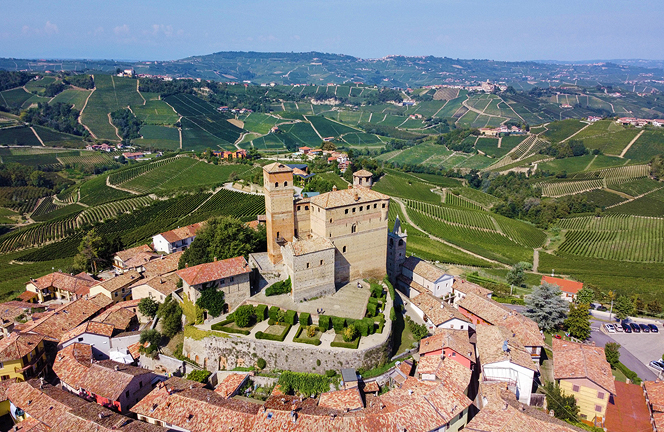
The castle was originally a fortified tower overlooking the village of Serralunga in the 12th century. This castle, one of the best preserved in the area, is unique in Italy for its architectural structure, which resembles a castle keep, and was used more to control local crop production than as a military castle. Purchased by the state in 1949 and deemed a cultural heritage site, is the perfect place to admire a spectacular view.
Traveling Through the Padana Valley
Morning
- Meet at 9:00 to leave for Borghetto sul Mincio. Rated among Italy’s most beautiful villages, this small picturesque hamlet rises right next to the Mincio river which feeds numerous mills.
- Stop in Cremona, a small, well-kept, mercantile city in the middle of the fertile Pianura Padana (Po Valley). The Stradivarius collection at the Violin Museum testifies to the city’s violin-making heritage.
Afternoon
- Visit to a luthier workshop to learn how violins are made.
Free time or optional activities:- Violin museum.
- The Cathedral with its Renaissance arcade, and the 8-sided Baptistery.
- The Torrazzo, the third tallest brickwork bell tower and with the largest astronomical clock in the world.
- Torrone (nougat) tasting in one of the historic pastry shops.
Welcome Aperitif.
Dinner at the hotel.
Cremona
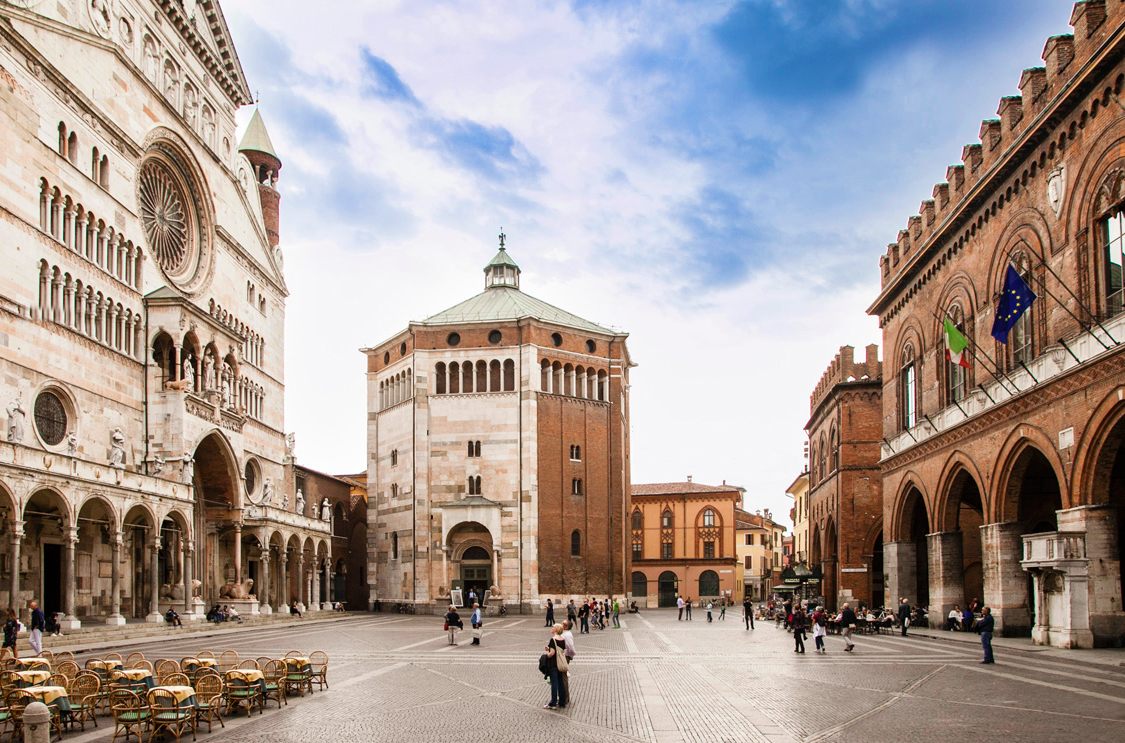
Cremona is described, for the first time in its history, as a settlement of Cenomani, a Gallic tribe of Celtic culture. Later, in 218 BC on the same site a Roman military outpost was established, their first one north of the Po river. Cremona is custodian of some fine medieval architecture such as the finely proportioned Romanesque cathedral, the adjoining Torrazzo (bell bower), the octagonal baptistery, the City Hall, and the Loggia dei Militi. Cremona is the birthplace of the Stradivarius and other string instruments and also a center of excellence for tasty cuisine in Northern Italy, and is famous for Mostarda di Cremona, a spiced fruit preserve and for the local torrone (nougat).
Borghetto sul Mincio
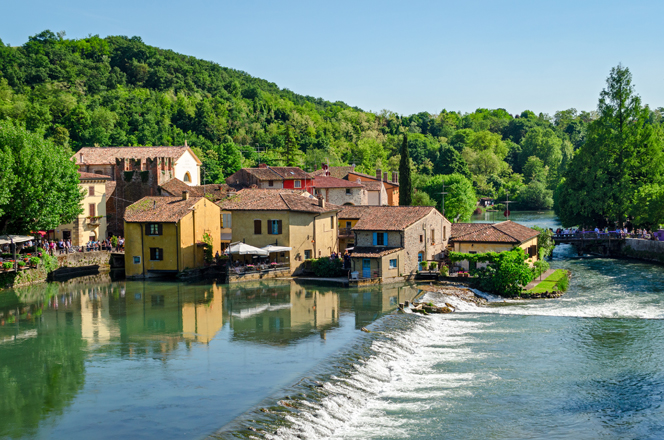
Located 20 miles south-west of Verona, Borghetto once was a strategic outpost on the river Mincio during the Lombard domination. In the past it was considered an important crossroads for traders and armies since Borghetto was part of the route taken by the people moving across Venetian lands where there were many economic and political interests. Among the various historical sites in the village, the most important is the fortified bridge Visconteo built in 1395, which also acts as a dam to divert the course of the Mincio river. Other buildings in the center of Borghetto sul Mincio date back to the mid-1300s, like the graceful church of San Marco Evangelista, founded in the 10th century and restored in the 1700s, flanked by its bell tower that contains a bell dating from the year 1381, one of the oldest in the area.
The City of Art, History and Superb Food
Morning
- Drive to Mantova (Mantua), considered one of the most important cultural cities during the Renaissance and still maintains most of the buildings from that period.
Walking guided tour:- Palazzo Ducale, a monumental architectural complex and a museum.
- San Giorgio Castle, part of the Ducal Palace, is one of the most representative examples of late medieval military architecture.
- Camera degli Sposi (Bridal Chamber), frescoed with illusionistic paintings by Andrea Mantegna.
- Bibiena Theater, designed in late Baroque early Rococo style.
Afternoon
- Free time or optional activities:
- Stroll in the historic center through Piazza delle Erbe and Piazza Sorbello.
- Admire the city from the top of the clock tower.
- Back to Borghetto sul Mincio.
- Take a 15 minute walk to the Parco Giardino Sigurtá (Sigurtà Garden Park) in Valeggio sul Mincio.
Mantova
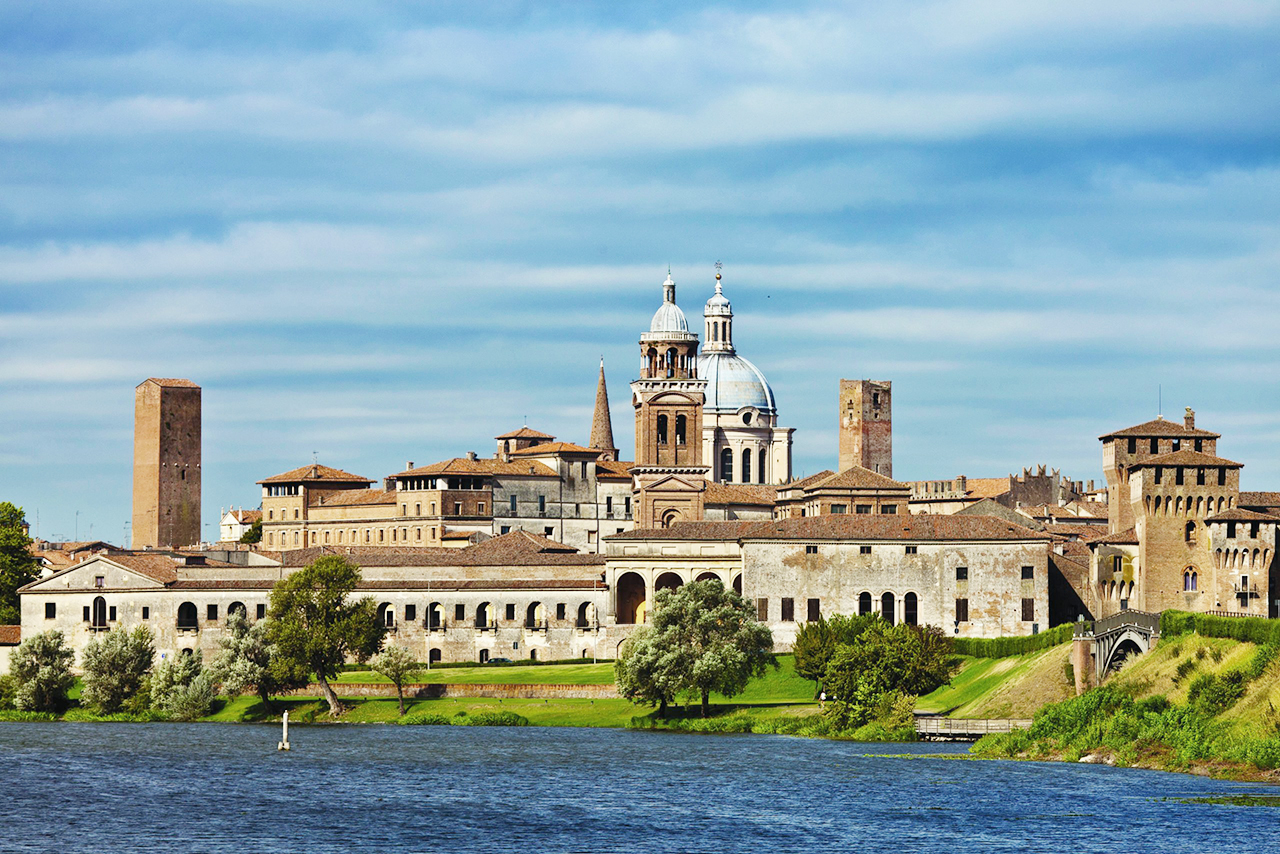
The locals refer to Mantua as ‘La Bella Addormentata’, a sleeping beauty that hasn’t changed much since the Middle Ages. The keys to this metaphor are the 3 artificial lakes surrounding the city on three sides, and a remarkable artificial fortification created nearly 1,000 years ago that effectively isolated Mantua from the world. This area is important from a naturalistic point of view, but not only, in fact research has highlighted numerous human settlements dating back to the Neolithic and the Bronze Age. In the 6th century BC, Mantua was originally settled by the Etruscans, before passing to the Gallics. With the Roman conquest the Mantuan territory was colonized by veteran soldiers of the Emperor Augustus. But the protagonists who made Mantua the city that can be admired today were the Gonzagas, a noble family who from 1320 to 1708 commissioned the construction of important buildings. Thanks to them the city became a musical and cultural powerhouse, a place today rich in historical significance. Mantua was designated in 2007 as a UNESCO World Heritage.
Palazzo Ducale
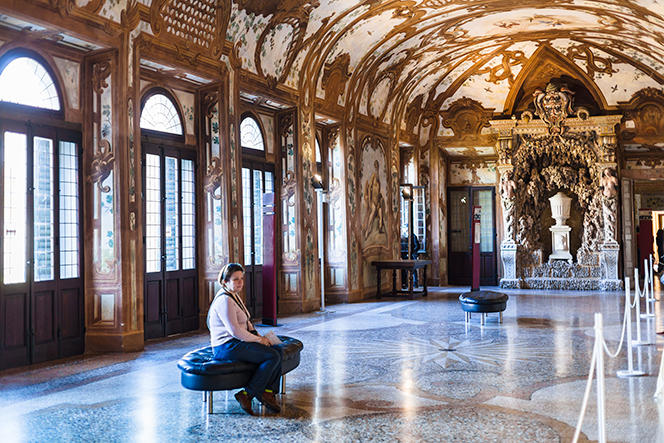
The Ducal Palace, also known as the Gonzaga Palace, is a large complex of historical buildings connected by corridors and galleries, enriched by inner courts and wide gardens, built between the 14th and the 17th century. It covers an area of more than 34,000 m2 (40,660 sq yd), which makes it the sixth largest palace in Europe after the Vatican palaces, the Louvre, the Palace of Versailles, the Royal Palace of Caserta and the Castle of Fontainebleau. It has more than 500 rooms and contains 7 gardens and 8 courtyards but the inside is now almost completely empty since the Gonzaga family, that ruled Mantova for many years, was forced to sell their art collections to the king of England first, and the rest of their belongings being taken away by Napoleon.
Castello di San Giorgio
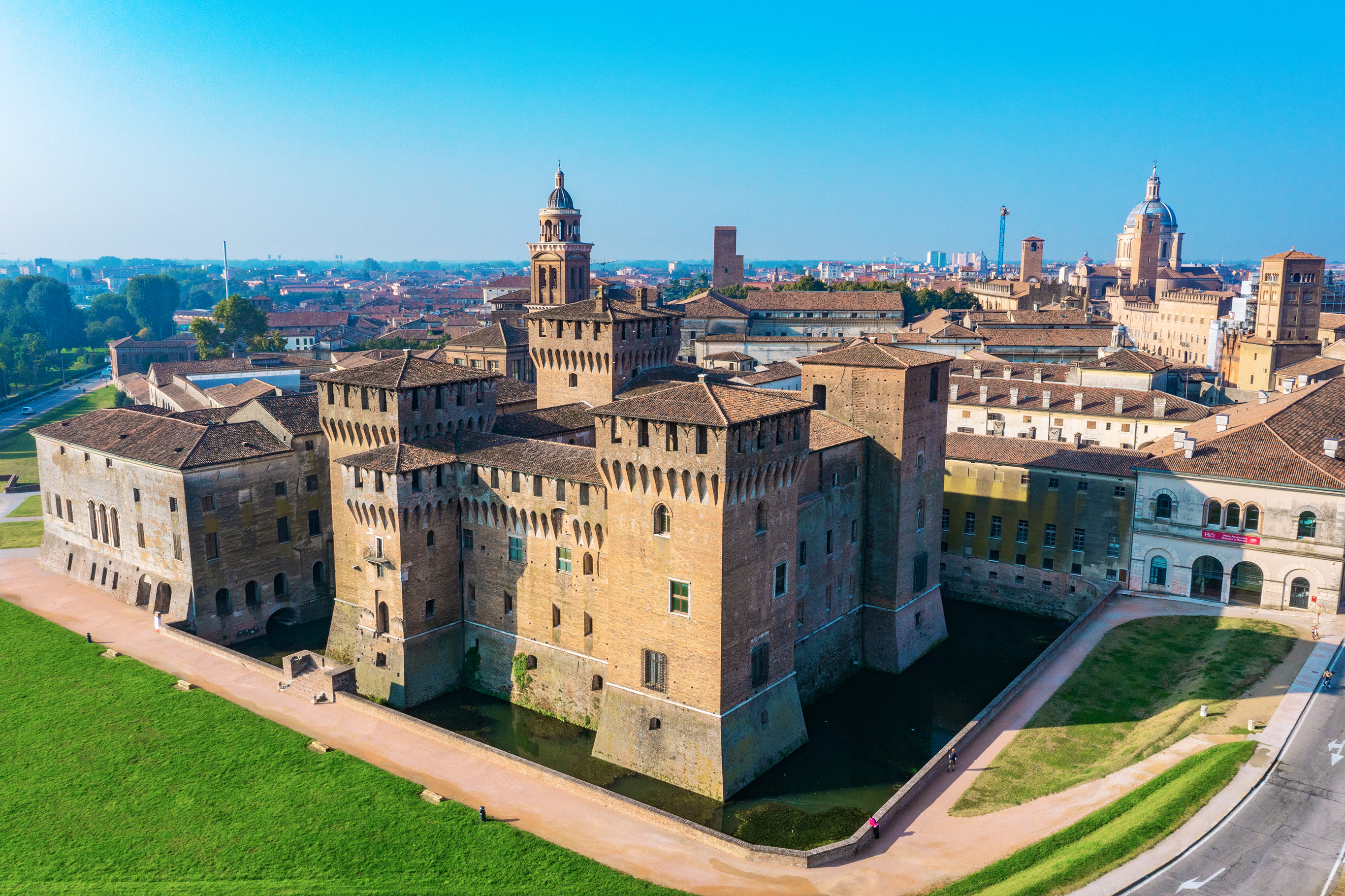
San Giorgio castle, part of the Ducal Palace, was originally completed as a defensive structure in 1406 and was later transformed into a Renaissance residential palace in 1459 at the request of Francesco I Gonzaga. It was erected to defend the city, with 4 corner towers surrounded by a moat crossed by 3 drawbridges. It is now one of the most representative examples of late medieval military architecture in Italy. The castle was the residence of Isabella d’Este, wife of Francesco II Gonzaga, one of the most influential noblewomen during the Renaissance. She invited to the castle numerous artists and humanists of the time, among them Leonardo da Vinci, the painter Andrea Mantegna and the poet Ludovico Ariosto. Inside the castle there are many beautifully decorated halls, like the Sala dei Soli (Hall of the Suns), decorated with 15th century frescoes, Sala delle Sigle, Isabella d’Este’s bridal chamber, Sala dello Zodiaco (Hall of the Zodiac), and Camera degli Sposi (Bridal chamber), with frescoes by Andrea Mantegna.
Teatro Bibiena
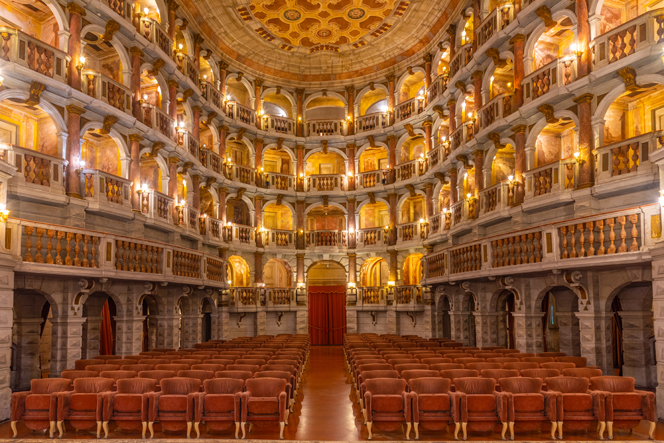
The Bibiena Theater, erected between 1767 and 1769, was designed in late Baroque-early Rococo style by Antonio Galli da Bibbiena who provided the monochrome frescoes in the interior while Giuseppe Piermarini designed and built the façade of the theater. It has a bell-shaped floor plan and four rows of boxes and followed the new style of theaters then in vogue. It was intended for theater productions and concerts, as well as scientific discourses and conventions. The theater is relatively small, with a scene 12,3 m wide (40 f) and 5,6 m deep (18 f), and a maximum audience of 363 people. It is famous around the world for its interior decoration, a real jewel where artistic and musical perfection can be achieved.
Parco Giardino Sigurtà
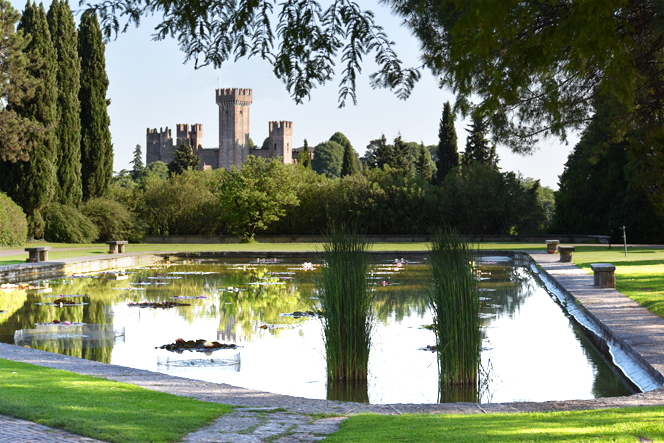
The history of the Sigurtà Garden Park dates back to 1407 when the property, owned by the noble Contarini family, was a farm or ‘brolo’, an enclosed wooded knoll with encircling walls, arable land and forage production for the livestock used entirely for agricultural purposes. In the late 15th century the Guarienti family took ownership for almost two centuries and during this period some of the agricultural potential of the land was sacrificed to increase the area dedicated to the garden. Today the garden extends on 60 hectares (150 acres) with lawns, woods, a million tulips and 30,000 roses, 18 ponds and lakes. Among the highlights of the park are the Avenue of the Roses, the Maze and the panoramic walk.
Lake Garda
Morning
- Drive to Sirmione, a dazzling town on Lake Garda one of the prettiest and quaintest villages of Italy.
- Scaliger Castle which guards the entrance to the medieval town.
- Grotte di Catullo, the remains of a large Roman villa located within a vast olive grove at the extreme tip of the peninsula.
Afternoon
- Drive along the east shore of the lake up to Malcesine to visit another Scaliger Castle, from where it is possible to enjoy a spectacular 360 degree view. On the way there, stop to visit Lazise.
Sirmione
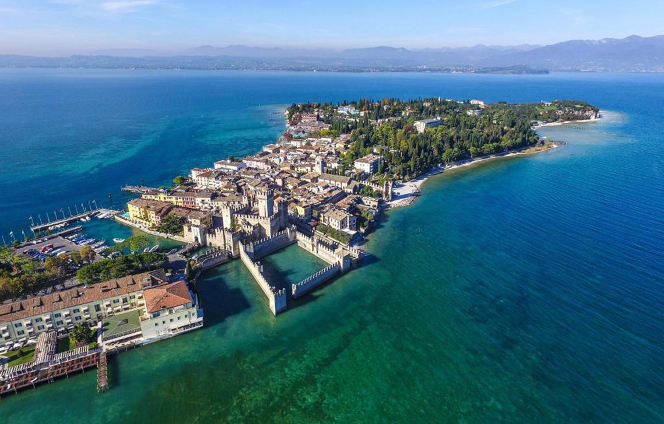
Sirmione is a city built along a narrow peninsula extending into Lake Garda, that gives you the feeling of being on an island. The first traces of human presence in the area date to the 6th–5th millenia BC. From the 1st century BC, Sirmione became a holiday destination for rich families, due in part to its natural thermal springs and spas. It has drawn intellectuals and nobles, including the likes of the latin poet Catullus and the opera diva Maria Callas. The main historical landmarks are the Grottoes of Catullus and the 14th century Scaliger Castle (Rocca Scaligera) that sits grandly in the center of town and is one of the best surviving examples of medieval port fortifications in the world.
Grotte di Catullo
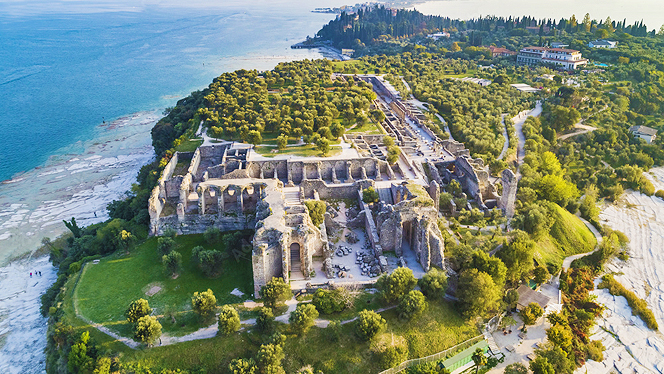
The Grottoes of Catullus is an archaeological site with ruins of a Roman villa, built at the beginning of the Christian era. In the 15th century the villa was ascribed to the poet Catullus but after some scholarly research, at present, there are no safe elements to locate the unequivocal house of Catullus. The term, however, prevailed and is still used to identify the archaeological complex which remains partially unearthed today and covers an area of about two hectares. The villa is an important testament of the Roman period in the Sirmione peninsula.
Castello Scaligero
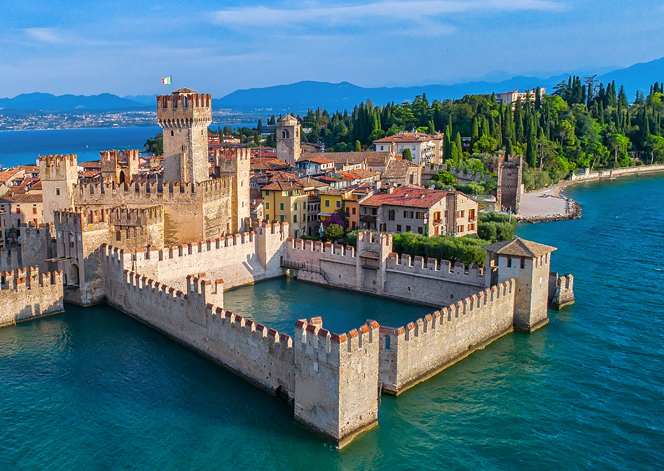
The Scaliger Castle, often referred to as the Rocca (fortress) of Sirmione, is the access point to the historical center of Sirmione. It is a fortification built after the mid-14th century on behalf of the Della Scala family of Verona, who are known as the Scaligeri from which it takes its name. Its towers and the geometries of merlons and walls, which draw its profile, make it an extraordinary example of a lakeside fortification and one of the most spectacular and best preserved Scaliger fortresses. Upon entering it is possible to see the courtyard, the walkways and the dock where the ships found refuge.
Lazise
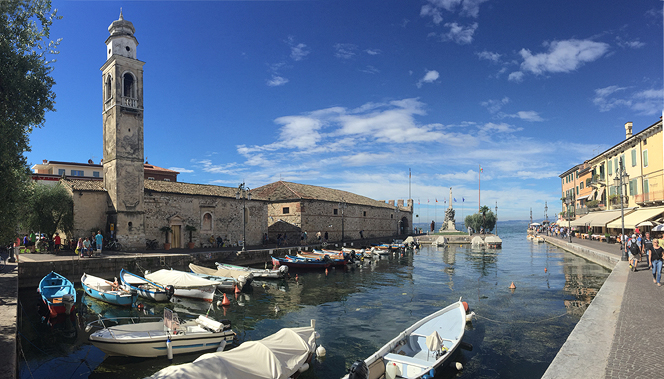
Lazise is a charming town located on the east shore of Lake Garda and is one of its most important touristic centers, thanks to its natural sites, nice shops and restaurants. The origin of the name comes from the Latin word lacus that means ‘lakeside village’. Lazise, like other cities on the lake shore, has its Scaliger castle which, however, cannot be visited. The colorful harbor, which still hosts fishing boats, was once an important port during the dominion of the Venetian Republic. The medieval walls, the old town center with the checkerboard-paved piazza and the narrow alleys make Lazise worth visiting.
Malcesine
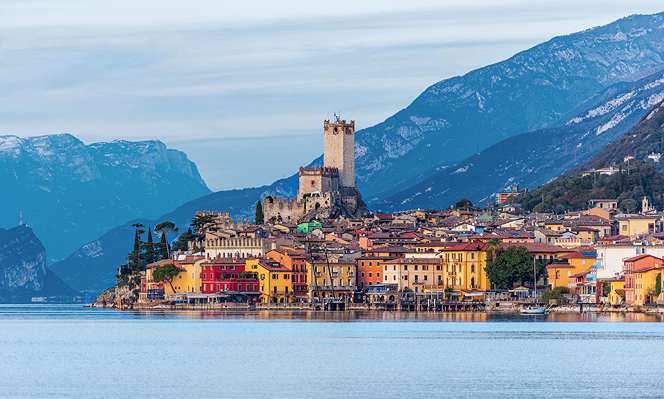
The symbol of Malcesine is its Castle, which was first built as a fortification during the 5th century by the Langobards and then destroyed by the Franks in 590. During the following centuries the fortress changed hands several times until the beginning of the 14th century when Alberto della Scala’s and his family rebuilt the structure which started to be referred to as the Scaliger castle. It was then occupied by the House of Visconti from 1387 to 1403. Later on, it was incorporated into the Republic of Venice to remain under its control until 1506, then it was owned by the French, followed by the Austrians. In 1902 the castle was declared a national monument.
Discovering Padova and Giotto’s masterpiece
Morning
- Drive to Padova (Padua), one of the oldest cities in Northern Italy. According to a tradition dated at least to the time of Virgil’s Aeneid, Padua was founded around 1183 BC by the Trojans.
Walking guided tour:- Cappella degli Scrovegni, Padua small version of the Sistine Chapel. It is one of Italy’s great Renaissance masterpieces, a striking cycle of frescoes by Giotto, the painter that other artist like Dante, Leonardo da Vinci and Vasari honor as the painter who ended the Dark Ages.
- Palazzo della Ragione, a medieval market hall, town hall and palace of justice building, a true miracle of architectural audacity and an impressive collection of 14th century mural paintings.
Afternoon
- Drive to Cittadella, the only walled city in all of Europe to have a medieval, fully elliptical, walkable parapet walkway.
Padova
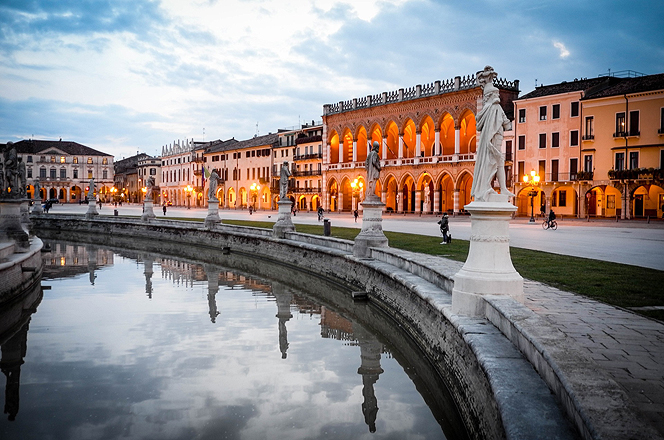
Padua is the economic capital of the Veneto region. Its historical center is the perfect fusion of medieval palaces, Renaissance buildings, cobbled streets, churches and modern architecture. Padua’s 800-year-old street market still thrives, bustling with locals and bursting with beautiful produce. Founded in the 10th century BC, Padua is considered the oldest city in Northern Italy. It has inspired Shakespeare, who set The Taming of the Shrew here. It is also home to the world’s fifth oldest university, which hosted Galileo as a lecturer. Padua was the wealthiest city in Italy outside of Rome at the end of the 1st century BC. During the early 13th century, the city prospered but it was in the next two centuries that Padua entered a period of extraordinary economic and cultural development, characterized by masterpieces like the wonderful frescoes by Giotto, the Basilica of Saint Anthony, and works by Andrea Mantegna and Donatello.
Cappella desgli Scrovegni
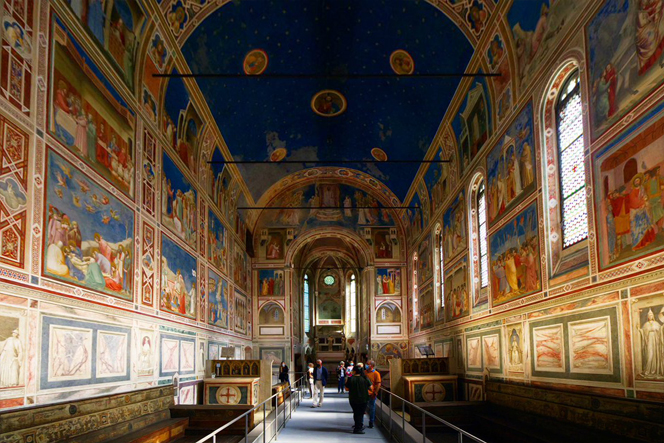
The Scrovegni Chapel was an annex to the Scrovegni family’s luxurious palace, built in the early 1300s, in the area on which a Roman arena had previously stood. Enrico Scrovegni wanted this chapel as the family’s private oratory and also as a funerary monument for himself and his wife. The Chapel contains one of Giotto’s most important and complete series of fresco cycles, masterpieces that were considered innovative in the 14th century, because the figures are not stylized but have facial human expressions based on close observation.
Palazzo della Ragione
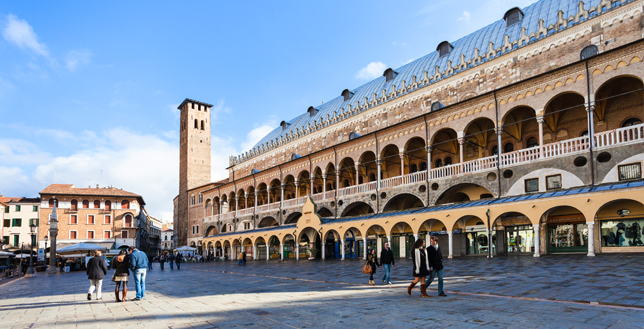
The Palazzo della Ragione was popularly called the Salone (the Big Hall). The vast room on the upper floor was at the time the seat of the justice administration and is one of the largest medieval halls still remaining. It measures approximately 82 m (270 feet) long by 27 m (88 feet) wide and is covered by a vertiginous ogival wooden structure almost 40 m (131 feet) high. It is decorated with about 500 frescoes, many of those originally painted by Giotto but destroyed by a fire in 1420. The gigantic wooden horse on the western side of the hall was built in 1466 and is modeled on Donatello’s Equestrian statue of the condottiere Gattamelata. On the eastern side there is a contemporary version of a Foucault pendulum and in the northeast corner of the hall is situated the ‘Pietra del Vituperio’. The ground floor of the building still hosts the historical covered market.
Cittadella
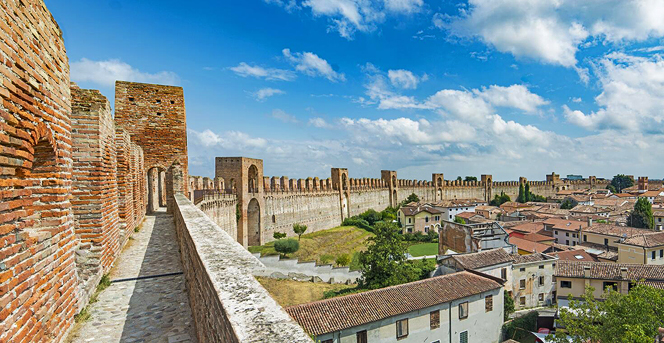
Cittadella in Italian means citadel, as the city was built in1220 as a fortified military outpost. The perimeter of the sturdy defensive walls is 1,5 km long (approx 1 mile) and were built over a long period of time using red bricks and river stones. There are four gates situated along the four cardinal points and separated just about 450 meters from each other and four keeps, 12 towers and 16 turrets. All around the walls there is a deep freshwater moat which served as defense, crossed by wooden drawbridges later replaced with stone ones. Thanks to an extensive restoration, the Cittadella’s walkway all around the walls, was opened to visitors in 2013 and offers panoramic views of the Venetian plains, the nearby mountains and the historic center.
The Romantic Verona
Morning
- Drive to Spiazzi, a small village located on the hills of Lake Garda.
- Take a 20-minute walk to get to the Sanctuary of the Madonna della Corona, a jewel nestled in the mountain, built over 2,000 feet above sea level into a vertical cliff face on Mount Baldo.
Afternoon
- Drive to Verona, setting of Shakespeare’s Romeo and Juliet.
Walking guided tour:- Arena, the grand 1st century Roman amphitheater.
- Piazza delle Erbe, created as a marketplace for commerce and exchange.
Madonna della Corona
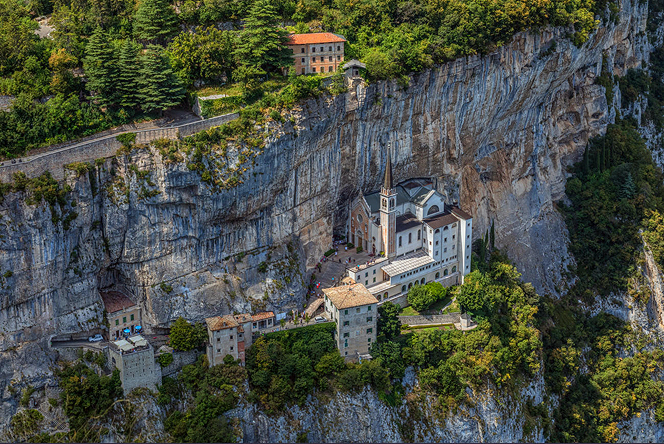
The Sanctuary of the Madonna della Corona is located in a rocky promontory at 774 meters above sea level, overlooking the valley of the Adige river. In the 13th century there was a monastery with a chapel accessible only by a dangerous narrow path in the rock, which during the following four centuries was radically transformed into a real spacious and accessible shrine where a Pietà, made in stone, is venerated as Our Lady of the Corona since the 15th century.
Verona
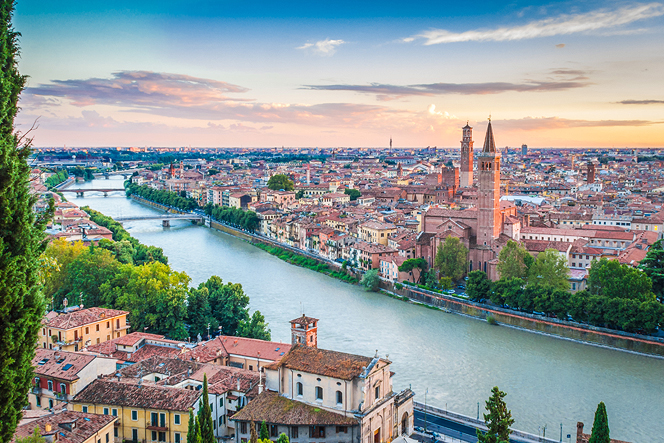
The history of Verona is closely linked to the river Adige, as it was used for trade and commerce. The core of the city is nestled in a loop of the river and contains one of the richest collections of Roman remains in northern Italy, the grandest of which is the amphitheater known as the Arena. There are many bridges today that connect the ancient center with the rest of the city. It was during the ruling of Della Scala (Scaliger) family that Verona achieved great prosperity becoming rich and powerful. With its 2000 years of history Verona is an extraordinary example of a town that has developed progressively by incorporating artistic architectural elements from various periods: Roman, Romanesque, Middle Ages and Renaissance.
Arena
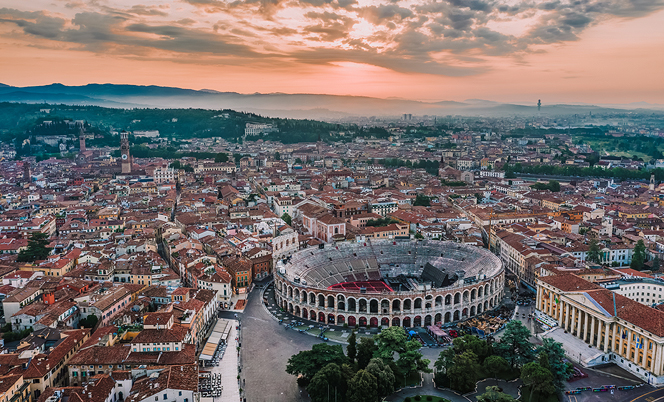
The Arena, built around AD 30, in pink-tinged marble, was the eighth-biggest amphitheater in the Roman Empire, with a capacity of nearly 30,000 people. The Arena was used during the Middle Ages for festivals and games until a major earthquake in 1117 badly damaged the structure’s outer ring. Thanks to its extraordinary acoustics some operatic performances were later mounted in the building during the 1850s. The first 20 century operatic production was the staging of Giuseppe Verdi’s Aida and since then, summer seasons of opera have been continually performed. In recent times, it has also hosted several concerts of international rock and pop bands.
Piazza delle Erbe
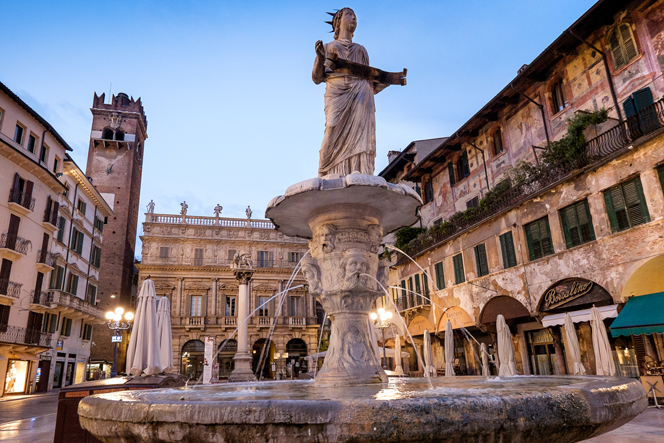
Piazza delle Erbe is the oldest square in Verona, built on the remains of the ancient Roman forum, for centuries has been the center of the commercial, administrative and social life of the city. It owes its name to the ancient aromatic herb market and still today there are vendors selling fruit, vegetables, typical products and souvenirs during the day to transform after sunset into the center of the nightlife par excellence. The Renaissance palaces with facades that still preserve lively 16th century frescoes contribute to make Piazza delle Erbe an open-air museum, elected “most beautiful square in the world” by a group of international newspapers. It is possible to enjoy an incomparable view of the city from the top of the ‘Torre Dei Lamberti’, after climbing 84 m (270 feet) or by taking a lift.
The Balsamic Vinegar
Morning
- Drive to Vignola where is located ‘La Cà dal Nôn’, a vinegary that produces traditional balsamic vinegar.
Afternoon
- Drive to Milano.
Farewell dinner nearby the hotel.
La Cà dal Nôn
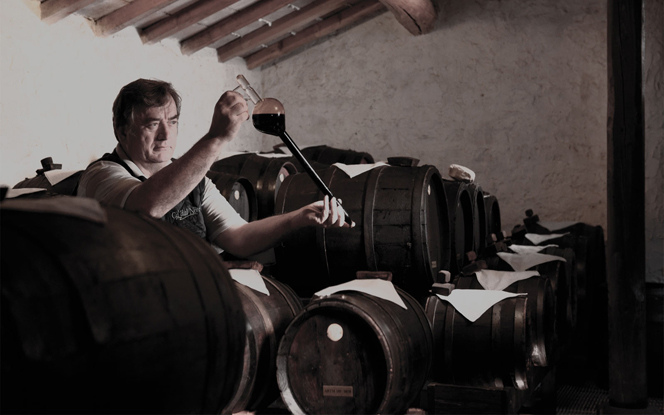
La Cà dal Nôn, “The house of the grandfather” in Modenese dialect. The vinegary has been producing Traditional Balsamic Vinegar of Modena for generations. It is a most ancient product of the Modena region and unique in the world. A vinegar based on cooked grape juice that must be aged by a long and slow vinegarization process, through natural fermentation followed by a progressive concentration by aging in a series of barrels made of different types of wood, and without any addition of any other spices or flavorings. According to Italian law, the traditional balsamic vinegar of Modena, can be made with only certain grapes that grow in Modena and its area, such as: Trebbiano Modenese, Lambrusco, Sauvignon and Pignoletto. The grapes are harvested at the pick of their ripening in order to get the highest concentration of sugar. The aging of the Traditional Balsamic Vinegar of Modena requires a minimum of 12 years, and at least 25 years for the extra aged.
Arrivederci! See you soon!
The day of departure has arrived, some of you ready to fly back home and others to continue their holiday to new destinations.
For those who are going to the airport a shuttle will come to pick you up at the hotel.
We wish you a good return or a good continuation and we hope to see you soon and remember that following your first tour, you will receive a $200 credit for future trips with Tour With Us!
Home | Tours | Policies | Photos | About Us | Contact Us
CST # 2129817-40
Copyright ©2017 Tour With Us. All rights reserved.
Web Site Design: Landini Design, Inc.
